Patient Updates, Cancer Journeys, and Reviews
Many of Issels' patients have shared cancer status updates with us. Many patients have had remarkable long term cancer remissions after our Immuno-Oncology treatment.

Learn More About the Cancer Journeys and Status of Many of Issels' Patients After Treatment
DISCLAIMER: No claim is made that patients with similar diagnosis and/or treatment(s) will respond to the same extent as the patients shown. All testimonials have been provided voluntarily to share a patient's experience with the Issels Treatment and their state of health at the time. Some patients may have passed away due to age or disease. None of these patients received compensation or are related to the Issels Treatment Centers.
Joseph Momot – Advanced Primary Liver Cancer, Hepatocellular Carcinoma, with a very high total bilirubin level of 20.3 mg/dl (06/09/10)
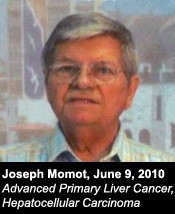 Within 4 weeks drastic improvement of condition, opening of bile duct, decrease of bilirubin from 20.3 to 5.2 mg/dl, disappearance of jaundice, edemas and pain.
Within 4 weeks drastic improvement of condition, opening of bile duct, decrease of bilirubin from 20.3 to 5.2 mg/dl, disappearance of jaundice, edemas and pain.
Watch Joseph Momot's testimonial. Joseph Momot, 71, was diagnosed with hepatocellular carcinoma in July 2009 after he started having pain on the right side of his abdomen. He received chemotherapy with conventional cancer treatment drugs from September 2009 to December 2009. After he finished chemotherapy he was told that it had helped to diminish some of his tumoral load, however, four weeks later the tumor re grew and in May 2010 his oncologists told him he only had few months to live and offered him to look into clinical trials.
• Joseph chose to come to the Issels Treatment Center in Tijuana, Mexico. He arrived at the Issels Treatment Center on June 9th 2010 and received the full non-toxic Issels Treatment Protocol including LAK cell therapy. Upon his arrival, lab tests reported his total bilirubin level to be 20.3 mg/dl. He had a direct bilirubin of 9.7 mg/dl, and an indirect bilirubin level of 10.6 mg/dl. After about one week into the Issels Therapy his laboratory results started improving.
•The last labs taken before his discharge home, on the 6th of July 2010, showed a remarkable improvement, reporting a total bilirubin level of 5.2 mg/dl, direct bilirubin 0.6 mg/dl and indirect bilirubin level of 4.6 mg/dl. During his stay he also manifested a marked improvement in his overall condition, with decrease of his jaundice, minimizing of his pain and edemas. His energy level went up, and he had no more swollen legs and could walk freely. In his words: "I feel like a new person", he had never experienced such a "great place". His recovery was so rapid that he calls the Issels Treatment Center a "miracle place". He was discharged on July 7th, 2010 with a comprehensive follow-up home treatment protocol.
• On July 28, 2010, he reported happily how well he has been feeling and that the new blood test at home revealed the further decrease of his total bilirubin to 2.1 mg/dl.
Mavis Goss – Non-Small Cell Lung Cancer with Metastases (March 2010)
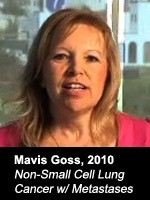 Tumor markers decreased after 3 weeks of Issels Treatment
Tumor markers decreased after 3 weeks of Issels Treatment
Watch Mavis Goss' testimonial. In October 2009, Mavis Goss was diagnosed as suffering from primary right lower lobe non-small cell lung cancer with regional metastasis to the right lung, pleura and mediastinum. She underwent lung surgery, a wedge resection excisional biopsy of right lung, which showed an adenocarcinoma Stage IV with features of non-mucinous bronchoalveolar carcinoma. Mavis deferred the recommended chemotherapy and radiation. Instead she changed her lifestyle, started juicing, taking supplements. Increasing pain alerted her that the disease was progressing.
• In March 2010, she started the Issels Treatment in Santa Barbara, California upon recommendation by another cancer patient because of her own treatment result. By the end of the non-toxic immunobiological treatment program at the Issels Medical Center, her tumor markers including, CEA, CA125, which were abnormally elevated upon admission, already showed a decrease. Mavis was very happy about this sign of good response in addition to the improvement of her overall condition.
Marilynn Grossball – Invasive Ductal Breast Cancer, Stage III (2007)
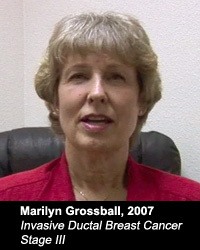 Tumor marker returned to normal after 3 weeks on the Issels Treatment.
Tumor marker returned to normal after 3 weeks on the Issels Treatment.
Watch Marilynn Grossball's video testimonial. In 2007, Marilynn Grossball was diagnosed as suffering from invasive ductal carcinoma which had spread to both sentinel nodes. She underwent lumpectomy. Her oncologist was strong and clear given the statistics that Marilynn's best shot was to receive big doses of chemotherapy, as well as Tamoxifen because of her estrogen-sensitive cancer. The surgeon who wanted to have all her lymph nodes removed advised that she see a radiologist as well. The radiologist gave her statistics about having 40% greater chance of living in 5 years if she does radiation for her fast-spreading Type III cancer. Marilyn wanted to build her immune system, detoxify and balance her body's defense functions, which made sense to her as a nurse and as a health educator. She refused chemotherapy and radiation.
• When she came to the Issels Medical Center in Santa Barbara, California in 2007, without any prior treatment, her cancer markers had doubled from the time of her lumpectomy, so there was reason to believe there was cancer in other parts of her body.
• After completion of the 3-week intensive and non-toxic Issels Treatment all her cancer markers were normal. She had her tests re-done 8 weeks after she left the clinic, and they were well within normal limits. She has been staying with the program consistently..
• She regularly goes to the center to boost her immune functions and continues to enjoy a normal life three years later, in 2010.
Kenneth Scoones – Metastatic Melanoma (09/11/08)
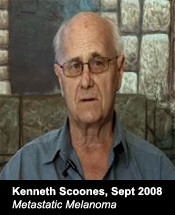 Remission of all of the multiple metastases in both lungs
Remission of all of the multiple metastases in both lungs
Watch Kenneth Scoones' testimonial. In May 2008 Mr. Kenneth Scoones was diagnosed as suffering from a reddish-black lesion, suspicious of melanoma, in his left anterior hemi thorax, just above the nipple. His family practitioner in the United Kingdom took a biopsy from the 1.5 cm lesion and one week later the pathology report confirmed the diagnosis melanoma. On June 18th 2008, he had a CT scan of the thorax and underwent surgery to perform a wide local resection of the melanoma on his left breast. A central lymph node biopsy was performed on June 20th 2008. Two weeks later he was informed that the central lymph node biopsy was positive for melanoma metastasis and that the CT scan showed multiple, uncountable pulmonary nodules consistent with metastases.
His doctors offered him to start chemotherapy with the forewarning that it would have severe side effects and that it might only add one year of life but that they could not assure a positive outcome. Instead of undergoing chemotherapy Kenneth decided to try the comprehensive non-toxic Issels Treatment. He arrived at the Issels Treatment Center on September 11th 2008 and the complete non-toxic Issels treatment protocol was started without any delay. During his 4-week stay he maintained a very positive attitude, enjoying the healing environment of the Center. On October 6th 2008 a thoracic CT scan was performed and the comparison with his previous thoracic CT scan dated June 18th 2008 revealed the remission of all the pulmonary metastases seen in the previous study. At the time of his discharge on October 9th Kenneth was discharged with the high energy level of KPS at 100, and eager to continue his complete home treatment protocol. The CT scan of February 6, 2009 in the UK confirmed the remission of all the lung metastases seen on the CT scan of June 18, 2008 in the UK before Kenneth started the Issels Treatment. He has followed his home care program and had no other treatment since.
• Kenneth came to the Issels Treatment Center for 5 days in April 2009 for his follow-up visit and everybody was happy to see him in such a great condition. The Scoones family wrote their story on their website, www.1dad1life.com, and here we quote: October 23, 2008: "after 4 weeks of intensive, ALL NATURAL treatment, dad had his latest scan. Having had over 100 small tumors on his lungs, the new scan showed that every single one had completely GONE, Dad is in REMISSION." You can only imagine the shock and the emotions. We are absolutely thrilled and very happy that we didn't give up hope and made the decision to go to Issels.
• April 2009: "It's been 6 months since we were last at the Issels Center and Dad and I (Soozi) have just been back there for his follow up. He is still in remission and clear of cancer. He continues to follow the home care program and is doing really well."
Thelma Gross – Non-Small Cell Lung Cancer, Adenocarcinoma, with hilar, mediastinal and paratracheal lymph involvement (03/09/09)
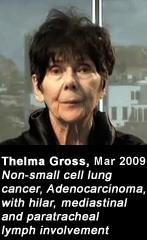 Within 4 weeks marked reduction of the tumor, remission of the lymphadenopathies
Within 4 weeks marked reduction of the tumor, remission of the lymphadenopathies
Watch Thelma Gross' testimonial. In February 2009, Mrs. Thelma Gross was diagnosed with a well-differentiated adenocarcinoma of the lung. In January 2009, she started with a productive cough that fluctuated in severity. As she did not respond to antibiotics her doctor decided to do a plain chest X-ray on February 3rd 2009 that showed a 5.2 cm mass in the upper lobe of her left lung. A subsequent CT scan confirmed a 5.2 cm left upper lobe mass contiguous with the left upper mediastinum at the level of the aortic arch.
The mass was also contiguous with the superior left hilum and was presumed to be most consistent with a primary lung carcinoma. There was left hilar adenopathy and abnormal soft tissue within the mediastinum in the right pretracheal region and subcarinal region indicating the presence of bilateral mediastinal adenopathy. Subsequently a bronchoscopy was done on February 13th 2009 with left upper lobe mass brushings and washings. The PET/CT scan of February 19th 2009 re-confirmed the finding of a 5.2 cm left upper lobe pulmonary mass, with evidence of mild left hilar, lower right paratracheal and subcarinal lymphadenopathy. Thelma underwent a fine needle biopsy and the final pathology report dated February 24th 2009 showed a well-differentiated adenocarcinoma. After evaluation of her studies, her oncologists recommended chemotherapy or a combination of chemotherapy and radiation, however, she chose a more integrative holistic approach to treat her cancer.
• On March 19th 2009, Thelma arrived at the Issels Treatment Center in good general condition and underwent the 4-week comprehensive non-toxic immunotherapy without any complications. She enjoyed the healing environment of the Center.
• At the end of the 4-week treatment at the Issels Treatment Center the comparison of the new chest CT scan of April 14th, 2009 with the previous CT scan of February 5th, 2009 showed a reduction of the lung tumor previously measuring 5.2 x 4.6 x 9.0 cm with a volume of 107.64 cm3 to 4.5 x 4.2 x 3.5 cm with an approximate volume of 33.07 cm3. The report also concluded that there was remission of the mediastinal and other lymphadenopathies previously found and that the rest of the thoracic structures and organs were within normal limits..
• On April 16th, 2009 Thelma was discharged in excellent condition, optimistic and with new enthusiasms to complete her home treatment protocol.
Herb Fritz – Squamous Cell Carcinoma of head and neck with lung and bone metastases (06/02/08)
 After 6 months into the Issels Treatment PET/CT scan shows full remission
After 6 months into the Issels Treatment PET/CT scan shows full remission
Watch Herb Fritz's testimonial. Herb Fritz, 58, was diagnosed with squamous cell carcinoma of the head and neck in January 2007. After his diagnosis he immediately started chemotherapy. He completed 3 cycles of chemotherapy with a conventional cancer treatment drug, and 5FU in 9 weeks plus 33 rounds of radiotherapy with chemo once a week that ended in May 2007. In 2007 he also had a gastrostomy tube placed.
In October 2007 a PET/CT scan showed that he now had multiple lung metastases and he started chemotherapy again in November 2007. The plan was to do 6 cycles, however, he only was able to complete 5 cycles due to extreme weakness and severe side effects that rendered him incapacitated for 3 weeks. He completed this chemotherapy in March 2008. The restaging PET/CT scan of January 17, 2008 had shown elevated glucose metabolism within the left piriform sinus, multiple lung metastases and evidence of right rib lesion consistent with bone metastases. His post-chemo PET/CT scan of April 10th 2008 showed his lung metastases less solidified, however, it demonstrated new metastases in the mediastinum.
• The patient first arrived at the Issels Treatment Center on June 02, 2008 feeling very weak in a very bad general condition. His first blood examinations indicated severely low levels of hemoglobin and a very low leukocyte count. He received blood transfusions without complications and was treated with Gramal, which is a human recombinant stimulating colony factor. He responded very well to the complete non-toxic Issels Treatment Protocol. At the time of his discharge on June 30, 2008 he expressed that he was feeling much better, with dramatic improvement of his general condition. In his own words his "quality of life was fully restored." He stated that his stay at the Issels Treatment Center had helped him even to recover from the severe side effects of his past chemotherapy and radiation.
• He went home with a complete home care treatment protocol, which he diligently followed through. The new PET/CT scan of December 2008 revealed that he is free of all malignant lesions. In January 2009 Mr. Fritz reported to the physicians of the Issels Treatment Center that he is very happy as his oncologist told him he is now in full remission.
• On his follow-up report of July 20, 2009: "Attached please find my latest bloodwork, PET scan, and CT scan, all dated July 20th, 2009. I am an Issels patient from June 2008 and am happy to report that I am still in complete remission. I feel good and have regained all my weight (40 pounds) and am back at work full time".
• On his next follow-up in July 12, 2010: "28 months after my last chemotherapy and 25 months after the start of the Issels Treatment, I am still in complete remission and enjoy a normal life, I work full time."
• Update of 2013: We recently got in touch with Herb and he reports that he is still in remission and enjoying his everyday life.
Gerhard Uhlemann – Head and Neck (epipharynx) Tumor (1972)
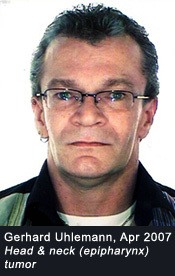 Cancer free for over 30 years
Cancer free for over 30 years
April 16, 2007: "I was treated at the Issels Clinic in 1972-1973 for head and neck (epipharynx) tumor. I was 12 years old and I am still thankful that Dr. Issels saved my life. Back then the University Clinic gave me 2 weeks to live. I am now 45 years old and never had any more symptoms."
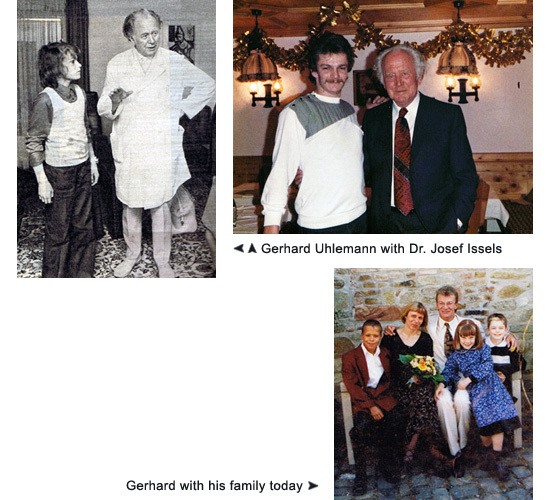
Laura Dunford – Inflammatory Breast Cancer with bone metastases and liver lesions (06/06/06 )
 After 1 month liver lesions disappeared, after 5 months bone scan virtually normal and breast tumor almost gone
After 1 month liver lesions disappeared, after 5 months bone scan virtually normal and breast tumor almost gone
Watch Laura Dunford's testimonial. In February 2001, Laura was diagnosed with a 9x11 cm infiltrative carcinoma in the lower external part of the right breast, which was estrogen and progestagen positive and Her2neu negative. It was a grade 3, highly aggressive tumor with a lymph node of 3x1.5cm in the axilla. The tumor was too large for surgery and no radiation treatment was administered. Laura received chemotherapy, the FEC regimen, which did not work well. Therefore, she was given taxotere. She continued with homeopathy and hormone blocking medication. This eradicated the tumor within 9 months until it started to grow back in 2005. She received more taxotere and tried the Natural Hygiene method of fasting. In June 2006 the bone scan revealed a metastasis to the sternum measuring 3x3 cm and liver lesions were diagnosed.
• When she started the Issels Treatment in June 2006, a tumor of 4x3.5 cm was palpated in the right breast. Upon her discharge from the 4-week Issels Treatment including the non-toxic vaccine program the CT scan did not show the liver lesions any more.
• After 5 months of the Issels home care program the breast tumor had shrunk to pea size and the bone scan was "virtually normal". The patient gained 20 lbs and is in very good condition with excellent attitude.
• Update of June 9, 2007: The recent bone scans of June 2007 "shows nothing in the hips, the shoulder or the spine". In spite of the bad prognosis of Laurie's oncologist she is still fit for work. "I'm very, very thankful for all the help I have received from the Issels team." – Laurie Dunford
Fall 2007: Laura during her visit to China

Update of January 2008: "I enjoy life and am very optimistic." Update of May 2008: Laurie in Alberta, Canada, two years after initiation of the Issels Treatment:
Update of December 2010: Almost 5 years after initiation of the Issels Treatment, Laurie enjoys her healthy lifestyle and continues her full time work.
Lucia Lizotte – Breast Cancer Stage IV with bone and liver metastases (08/05/07)
Remission of bone and liver metastases
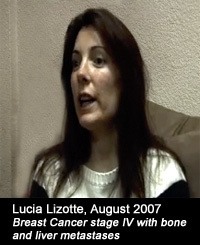 Watch Lucia Lizotte's testimonial. In June 2003 Lucia was diagnosed as suffering from breast cancer, left side, measuring 2.5 cm. The biopsy revealed a ductal carcinoma in situ, her-2, estrogen and progestagen positive. She had a lumpectomy and mastectomy, but did not opt for chemotherapy and/or radiation.
Watch Lucia Lizotte's testimonial. In June 2003 Lucia was diagnosed as suffering from breast cancer, left side, measuring 2.5 cm. The biopsy revealed a ductal carcinoma in situ, her-2, estrogen and progestagen positive. She had a lumpectomy and mastectomy, but did not opt for chemotherapy and/or radiation.
Shortly after surgery she became pregnant with her first child. In March 2007 Lucia complained about back pain. The PET/CT scans reveal metastases to the spine T12, L1, L5, and S1. The PET scan of March 13, 2008 shows multiple metabolic lesions of the liver (altogether 5), metastases of the left rib, T2, L2, L5, and sacrum. Treatment with the hormone blocker Tamoxifen was initiated. No other conventional treatment.
• In May 8th 2007, Lucia started the intensive 4-week non-toxic Issels Treatment including the vaccines and continues the follow-up home care program as the only treatment. On December 28th 2007, PET/CT scans reveal remarkable reduction in the number of osseous and hepatic metastases. The tumor remnants in T12, L1 and L5 are markedly diminished. The previously visualized foci on the left side of the liver have resolved (comparison March 2007) as well as the right lobar foci. Only one lesion remains centrally measuring 2.4 x 1.6 cm. No new metastases. Four of five liver metastases have resolved. Liver enzymes are within normal range, as well as tumor marker Ca 125 at 13.
• February 2008, Lucia is in very good condition leading a happy family life. During her follow-up visit to the Issels Treatment Center on February 29th, she states: "I thank God that my husband and I made the decision to come to Issels."
Jean Young – Breast Cancer with lung metastases and pleural effusions in both lungs (07/03/07)
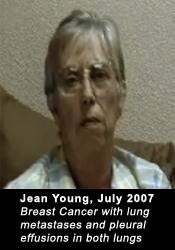 Within 3 weeks remarkable decrease of pleural effusions, improvement of oxygen saturation and overall condition
Within 3 weeks remarkable decrease of pleural effusions, improvement of oxygen saturation and overall condition
Watch Jean Young's testimonial. Mrs. Jean Young, 68 years old, was first diagnosed with Stage II, progesterone and estrogen receptor positive breast cancer in 2001. She had a bilateral radical mastectomy in 2001 and had a course of 6 months of the hormone blocker Tamoxifen. In April 2007 she developed thoracic pain, shortness of breath, fatigue and the X-ray showed pleural effusions in both lungs and atelectases in the right lung. Lung metastases were diagnosed and she underwent drainage and a talc pleurodesis was performed. In spite of this procedure she continued to develop fluid in her lungs that had to be drained every 15 to 20 days. In May 2007 she started a conventional cancer treatment drug for 23 days and stopped it because of severe side effects.
• She arrived at the Issels Treatment Center on July 3rd 2007 and underwent the full non-toxic Issels treatment protocol until July 31st 2007. When she started the Issels Treatment she had difficulty breathing, her oxygen saturation was between 82-90% with the need to use oxygen occasionally. The blood test showed a very high platelet count of 700.000 and she was fatigued. After 2 weeks of treatment she felt already stronger and noticed a remarkable improvement in her overall well being. The CT scan of July 23rd, 2007 shows that the pleural effusion in the left lung disappeared and the pleural effusion in the right lung decreased from about 25-30% to 10%. Her oxygen saturation improved to 97%. Her blood values normalized, the platelet count with 379.000 was within the normal range again and she did not need a pleural drainage anymore.
• At her discharge, her Karnofsky Performance Scale (KPS) was estimated to be 100, she had no breathing difficulty anymore, tolerated and enjoyed exercising 20 minutes a day. She left with her at home treatment protocol, which she followed for 5 months. At home she continued to respond very well to the treatment, the chronic pleural effusion of 10% in the right lung did not cause any respiratory problems and since the beginning of the Issels Treatment she did not require a pleural drainage anymore.
• The PET/CT scan of February 2008 does not reveal any new metastases and the chronic pleural effusion of 10% in the right lung does not show any metabolic activity, enabling Jean to lead a normal, active life.
• January 2009 update: Jean reports to be in very good condition.
Jacinta McShane – Invasive Breast Cancer with lung metastases (02/21/07)
 Very good response to treatment February 2009 excellent condition
Very good response to treatment February 2009 excellent condition
Watch Jacinta McShane's testimonial. Jacinta McShane, 57, from the U.K. was diagnosed with Breast Cancer Grade 3 Stage 2 in May 2004. A lumpectomy was performed on the left breast in June 2004. The tumor was both estrogen and progesterone receptor positive, and HER2 positive. She had to undergo further wider excisions as margins were unclear in July 2004 and again in August 2004. Finally a mastectomy of the left breast was performed in September 2004. At this time her doctors recommended chemotherapy and radiation but she refused. In November 2004, treatment with Tamoxifen was started and discontinued in February 2006. In May 2005 she had chest wall relapse along the mastectomy scar line.
The biopsy of this lesion indicated invasive cancer with some residual carcinoma. Radiotherapy treatment was started from September to October 2005. Sadly, on January 25, 2006 a CT of the Chest, abdomen and brain revealed several pulmonary nodules in the right upper lobe, left lower lobe and right lower lobe, with radiotherapy changes in the left lung and a small left pleural effusion with no significant mediastinal or hilar lymphadenopathy. Fortunately no bone metastases and no cerebral metastases were identified. In March 2006 she was started on Zoladex and Herceptin.
• On February 21, 2007 Jacinta arrived at the Issels Treatment Center. Her liver enzymes were elevated and on March 2, 2007 her tumor marker CA 27-29 was 22.6 U/ml. She responded very well to our immune stimulation and detoxification. Her liver enzymes dropped to normal and the tumor marker CA 27-29 decreased to 18.5 U/ml. She was discharged in very good condition on March 20, 2007 after she completed successfully our full non-toxic treatment program.
• On August 20, 2007 a CT scan of her thorax and abdomen was performed and compared to her CT from February 7, 2007. It showed no significant lymphadenopathy within the thorax. No change in an 8 mm pleural nodule in the lingula. Lungs were clear apart from minor radiation fibrosis peripherally in the left upper lobe, abdominal organs unremarkable and no bone metastases were identified. In September 2007 she stopped Zoladex but continued with Herceptin.
• On May 2008 she restarted Zoladex. Her CA 15-3 tumor marker was 18 IU/ML on January 25, 2008 and it reduced to 14 IU/ml on July 31, 2008. Jacinta visited the Issels Treatment Center two more times on separate occasions to boost her immune system, once from April 14, 2008 to April 19, 2008 and the second time from October 29, to October 31, 2008. She also continues to take Zoladex and Herceptin within the context of the Issels Treatment home care program. The CT contrast scan of chest and liver on August 4, 2008 showed no axillary or supraclavicular lymph node enlargement, no change in the lingular subpleural nodule. No new nodules are seen. Within the limits of the study, there is no evidence of liver metastases, no retroperitoneal or chest lymph nodes are identified and no destructive bone lesions.
• In February 2009 Jacinta reports to be very active and happy. In December 2009-January 2010 Jacinta returned to the Issels Treatment Center for a 2-week follow-up visit and immune boost. She was in very good condition. In October 2010 her book, "Hidden Gifts" was published in the UK. She shares her experience with the Issels Treatment on her website.
• Update of January 2018: Jacinta is 10 years cancer-free after the Issels Treatment and is in very good condition.
Here is Jacinta with her son last year: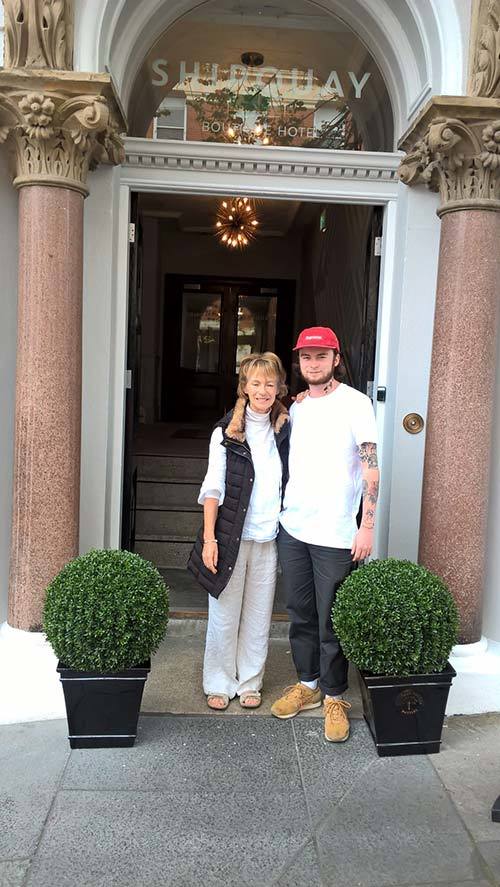
Quynh Trinh – Breast Cancer with multiple bone and lung metastases, oxygen-dependent (08/13/08)
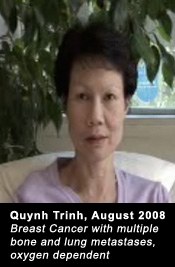 Within 4 weeks no oxygen dependency anymore breast lesions flattened
Within 4 weeks no oxygen dependency anymore breast lesions flattened
Watch Quynh Trinh's testimonial. In September 2004, Quynh Trinh was diagnosed with high-grade ductal carcinoma in situ of the right breast with micro calcifications. In February 2006 she noticed a lump in her right breast which ulcerated, along with other skin changes. On March 23, 2006 she underwent a modified radical mastectomy followed by reconstruction surgeries. The pathology report from the surgery revealed a T4bN2aMX stage, invasive carcinoma with Paget disease of the right nipple as the final diagnoses. There was extra-tumoral lymphatic and vascular invasion with local perineural invasion, Bloom-Richardson Grade 3, finding 7 positive lymphatic nodules of 7 resected, with negative estrogen and progesterone receptors but positive Her2/NEU (HERCEP). From April 2006 to July 2007 Quynh underwent chemotherapy with conventional cancer treatment drugs, followed by Taxol and Herceptin (trastuzumab). In addition she received radiotherapy from January 2007 to March 2007.
In October 2007 she developed evidence of bone metastases in the sternum and lung metastases, therefore Herceptin was re-initiated plus Gemzar. However, Gemzar was suspended and Herceptin was administered from November 2007 to July 2008. In July 2008 she started to present cough, dyspnea (shortness of breath), and was diagnosed with a spontaneous pneumothorax (collapsed lung) due to the cancer in her pleura. She also had anemia and a small pericardial effusion. On July 24, 2008 she had a PET/CT scan of her whole body. The comparison with the one done on January 22, 2008 showed increase in size, number and hypermetabolic activity within multiple pulmonary metastases consistent with interval disease progression. There was increased size and hypermetabolic activity within sternal metastases too.
• On August 13, 2008 she started the intensive non-toxic Issels Treatment program. When she arrived she was 24 hours oxygen dependent due to her collapsed lung and had great difficulty breathing. Her shortness of breath made it difficult to eat, she also had pain in the sternal area in her chest where the metastases were. She had paresthesias with pain in the upper right extremity with limitations in the range of movement. She presented with five elevated verrucous papules in the skin of the right breast that varied in size from 1 x 1 cm to 2 x 2 cm, and there was a lesion in the right nipple, of approximately 3 x 2 cm in diameter. During her 4-week stay she received the complete non-toxic Issels Treatment protocol customized for her, without any standard cancer treatment. She experienced a dramatic improvement of her shortness of breath, which improved also her appetite. Her energy level went up considerably, she was not oxygen dependent anymore, and her pain minimized. The lesions in her right breast also flattened.
• On September 10, 2008 Quynh was discharged with a comprehensive follow-up home treatment protocol. Two weeks after her discharge, her stabilized condition enabled her to undertake a recreational trip to Egypt, which she had planned a while ago and from which she happily returned to her home in the US.
Patricia Quintana – Invasive Ductal Breast Cancer Stage IV with Bone and Liver Metastases (11/06/08)
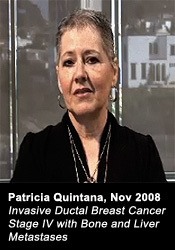 Within 4 weeks dramatic improvement of overall condition and recovered mobility, drop of tumor marker
Within 4 weeks dramatic improvement of overall condition and recovered mobility, drop of tumor marker
Watch Patricia Quintana's testimonial. In May 2005, Patricia Quintana was diagnosed with ductal carcinoma of the right breast with lymph node involvement. A lumpectomy was performed and the pathology report confirmed the diagnosis of invasive ductal carcinoma. She refused the recommended bilateral mastectomy and changed her lifestyle. In the fall of 2006 she started to have extreme pain in her right lower extremity and she also noticed that she developed suppurative lesions in her right breast. A series of tests revealed that the cancer had spread to the bones and in April 2007 metastases to the liver and pelvis were found.
She underwent chemotherapy with conventional cancer treatment drugs from April 2007 to October 2007 and finished 6 cycles to achieve cytoreduction. A bilateral mastectomy was performed in September 2007. She received radiotherapy from October 2007 to December 2007. In January 2008, follow-up imaging studies revealed increased hepatic metastases. Another cycle of chemotherapy started on February 4th 2008 and finished in July 2008. Imaging studies from September 2008 showed progression of the metastatic disease in the liver and the bones. The larger metastatic lesion in the liver measured 5 cm and the metastatic bone lesions where predominantly in the cervical spine, sternum, ribs, right femur, pelvis and cranium.
• After going through surgery, chemotherapy and radiation Patricia wanted to seek a more holistic integrative approach to treat her cancer and decided to come to the Issels Treatment Center. She started the Issels Treatment on November 6th, 2008. At her arrival Patricia had generalized osteo-muscular pain more prominently in her right thigh and right knee, she could not extend her right lower extremity and this made walking difficult for her, she also had lower back pain and hip pain.
• Patricia underwent the complete non-toxic Issels Treatment Protocol and during her 4-week stay she experienced dramatic improvement in her overall well-being, she got rid of her excruciating pain. She fully recovered mobility in her lower extremity. She can now lift and extend her leg completely, movements that where impossible for her to do for the past two years. She is happy to be able to walk again. Her tumor marker CA27-29 was 118.5 U/ml at her arrival, and at the end of her stay it went down to CA27-29: 111.4 U/ml.
• She was discharged on December 4th 2008 with a comprehensive follow up home treatment protocol. End of January 2009, Patricia reports to be in very good condition.
Carol Gayle – Renal Cell Kidney Cancer with Lung and Bone Metastases (04/12/07)
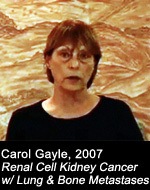 After one year into the Issels Treatment tumors have decreased in size and no new tumors showing
After one year into the Issels Treatment tumors have decreased in size and no new tumors showing
Watch Carol Gayle's testimonial. On August 16th, 2006 Carol Gayle, 64 years old, was diagnosed as suffering from metastatic kidney cancer. The CT scan revealed a large left hypernephroma (kidney cancer) that measured 8.2 x 9 cm, left renal vein thrombosis with pulmonary, mediastinal, pulmonary hilar metastases and a 2 cm enhancing soft tissue mass in the medullary cavity of the distal third of the right femur, and a second, approximately 4 mm lesion in the anterior cortex of the same femur, compatible with a malignant metastasis. A nuclear bone scan on August 29th, 2006 confirmed these findings and a biopsy of the right distal femur on September 14th, 2006 showed a poorly differentiated adenocarcinoma with features consistent with MRCC. She underwent an operation for an intramedullary rod of the right distal femur, and curettage, argon beam and cementation of the cavitary defect on September 14th, 2006.
Following this surgery she was treated with a conventional cancer treatment drug for 8 weeks and in December 2006 her left kidney was surgically removed. The pathology report of December 12th, 2006 revealed a renal cell carcinoma (14.0 cm in largest dimension), conventional (clear cell) type, Fuhrman nuclear grade 4, with extensive necrosis (75% of the tumor), invasive into perinephric adipose tissue and renal vein, Stage pT3b N0/35 M1 G4. Carol suspended the radiotherapy offered. Instead she entered an experimental program that she did not tolerate.
• Subsequently she looked for alternative options and without any further standard treatment she chose immunotherapy, the Issels Treatment. Carol Gayle underwent the intensive program of comprehensive non-toxic Immunotherapy at the Issels Treatment Center from April 12th, 2007 until May 5th, 2007 without complications. A superior abdomen CT Scan of April 30th, 2007 revealed that there where multiple nodular lesions on both inferior pulmonary lobules without change from the previous study of March 21st, 2007, a surgically absent left kidney and left adrenal, hepatic hypodensities on right lobule of .4 cm that had not changed from the previous study, and the rest of the superior abdominal images were normal.
• The comparison of the chest, abdomen and pelvic CT scans of January 8th, 2008 with the ones of October 11th, 2007, showed that there is an interval decrease in size of a right middle lobe nodule. Additional pulmonary nodules are stable. There is interval improvement of the right hilar and aorticopulmonary window adenopathy, stable low-density left hepatic lobe lesion, indeterminate and surgical changes of prior left nephrectomy are without findings to suggest recurrence. The findings of her bone scan of January 9th, 2008 were similar to the ones seen on October 5th, 2007 and do not appear suspicious for potential metastatic disease, but are felt to be post surgical and degenerative in origin.
• March 17, 2008 on Carol's second visit to the Issels Treatment: "I've been on the Issels Program for a year. Every three months I have my CT scans and bone scans and every time I've gone since a year ago they have been improved. My tumors have decreased in size every time, there's no new cancer showing and I continue to be on the Issels Treatment and it's done very well for me."
• As part of her follow-up treatment protocol, Carol's second visit to the Issels Treatment Center was on March 17th, 2008. She has gained weight, felt much better and was very happy about the drastic improvement of her condition. Carolyn in her own words: "I've been on the Issels Program for a year. Every three months I have my CT scans and bone scans and every time I've gone since a year ago they have been improved. My tumors have decreased in size every time, there's no new cancer showing and I continue to be on the Issels Treatment and it's done very well for me."
• In September 2013 Carol reports to be in very good condition.
Tom Howell – Colorectal Cancer with lung metastases Stage IV (05/08/06 )
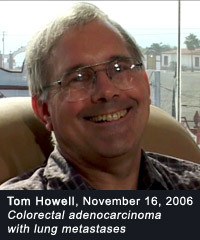 Number and sizes of mediastinal metastases decreased as well as tumor markers
Number and sizes of mediastinal metastases decreased as well as tumor markers
Watch Tom Howell's testimonial. In 1999 the patient had a colorectal adenocarcinoma surgically removed. Chemotherapy with 5FU and Leukovorin for 6 months and radiation therapy for 6 weeks followed. In September 2004 a recurrence was diagnosed in the same area and metastases to the lungs which were confirmed by biopsy as well as 2 nodes in the sternum.
Another 6 months of chemotherapy from October 2004 until April 2005 followed with conventional cancer treatment regimens and drugs with the side effect of nausea, diarrhea, mouth sores, neuropathy and other complications. In November 2005 a PET scan revealed that the cancer continued to grow and in December 2005 a third round of chemotherapy started for 3 months with the Folfuri regimen which replaced the Oxaliplatin in the previous regimen with Irinotecan. In March 2006 an ileostomy became necessary.
• On May 8, 2006 Tom was admitted to the Issels Treatment Center where he received the comprehensive immunotherapy including the vaccine protocol. Upon discharge from the intensive 4 week in-patient treatment the CT scan showed a decrease of the number and sizes of the metastases in the mediastinum and parenchymal tissue of the lungs.
• Tom continued the home care program, regained weight and his energy. November 16, 2006, Washington, USA, the patient in his own words: "I feel great. I have resumed my activities and thank my doctors at the Issels clinic for their excellent care. I also very much appreciated the warm "healing environment" of the whole place, which made us sometimes feel like being on vacation rather than in a hospital. The nearby ocean did its part, too."
• May 21, 2007. One year after the start of the Issels Treatment, the patient in his own words: "According to my recent test, my CEA tumor marker is at 1.9 within the normal range. I still follow the Issels diet and supplement program, and exercise regularly. I have been able to resume my work part time."
• January 2008: "I feel excellent."
Susan K. Baker – Colorectal Cancer with lung metastases (10/15/06)
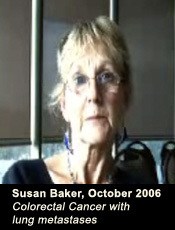 Remission and excellent condition
Remission and excellent condition
Watch Susan Baker's testimonial. Susan K. Baker, 60, was first diagnosed with rectal adenocarcinoma classified T3 N1 M0 in June 2001. In July 2001 she underwent a colostomy and intestinal resection. The colostomy was closed in September 2001. She had chemotherapy with 5-FU from October 2001 to May 2002. In 2005 she developed pulmonary symptoms and a PET/CT was performed on November 8th 2005, which indicated metastatic lesions in the left lower pulmonary lobe close to the left hilum with a maximum SUV of 10.3 mm and in the right upper pulmonary lobe with a maximum SUV of 12.4 mm.
She received chemotherapy with conventional cancer treatment drugs from December 2005 to January 2006; posterior to this on June 14th 2006 a metastectomy was done and the left apical lower and posterior basal segment of the lung was removed, measuring 90 x 40 x 20 mm with a nodule measuring 10 x 10 x 8 mm that showed on microscopic examination a moderately differentiated adenocarcinoma consistent with bowel origin. On August 8th 2006 a right upper lobectomy was done; the right upper lobe measuring 150 x 105 x 30mm with a tumor arising towards the hilum measuring 16 x 12 x 8mm. The microscopic examination of this section showed an adenocarcinoma with prominent tubular architecture with features entirely in keeping with a metastasis from the large bowel.
• Looking for a more holistic integrative approach to cancer she first arrived at the Issels Treatment Center on October 15th 2006. At this time she presented peripheral neuropathy of the inferior extremities due to the chemotherapy that she had received. During her 4-week stay she received the complete Issels Treatment protocol and was discharged on November 12th 2006 with a comprehensive follow up home treatment protocol.
• She continued with her home treatment without any problems. Her second visit to the Issels Treatment Center was from June 18th to June 24th 2007. During this second visit she conveyed she feels in excellent general condition and is asymptomatic with a KPS of 100, ECOG 0. On June 21st 2007 her CEA was 0.6 ng/ml.
• We continued with her home follow-up treatment program. Her CEA never increased and her CT scan in December 2007 showed no evidence of recurrence or metastasis. Her MRI of May 6th 2008 offered reassurance with regard to her skull base showing no metastasis. Her CT scan of August 21st 2008 did not show any evidence of recurrence and her CEA remained within the normal range.
• Her second follow up visit to the Issels Treatment Center was from September 29th to October 2nd 2008. She continued to be in very good general condition and asymptomatic. For the past two years she has not received any other treatment but the Issels Treatment, which she trusts. She conveyed her gratitude for the treatment result and the quality of life she regained.
• In 2013, Susan informed us that she is still doing well.
Carol Leahy – Colorectal cancer with big liver metastases (12/24/08)
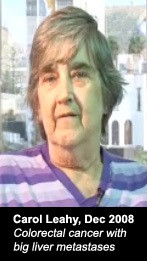 Within 4 weeks substantial improvement of overall condition, flattening of abdomen, drop of tumor marker
Within 4 weeks substantial improvement of overall condition, flattening of abdomen, drop of tumor marker
Watch Carol Leahy's testimonial. Carol Leahy, 70, was diagnosed with moderately differentiated mucinous adenocarcinoma of colorectal origin with liver metastases in October 2008. Carol felt a firm mass below her right rib cage, which was elevated, and suffered from nausea, vomiting, and weight loss. Her family physician referred her to a gastroenterology specialist who did a chest, abdominal and pelvic CT on October 24 2008. This CT showed a 6 cm mass like area thickening of the ascending colon, highly suspicious for a primary colon carcinoma, at least two solid liver lesions, the dominant one 19 x 11 cm in size involving most of the right lobe and the medial segment of the left lobe, and a second 4.1 x 4.3 cm solid lesion also in the medial segment of the left lobe, and multiple appearing cystic foci, the largest one measured about 5.9 x 4.1 cm.
A CT guided needle biopsy of the larger right lobe hepatic mass was performed on that same day, and the pathology report indicated a metastatic moderately differentiated mucin producing adenocarcinoma consistent with primary colorectal origin. Her tumor marker, CEA, was 1070.0 ng/ml on October 25th 2008; the normal value for this marker is from 0 to 3 ng/ml. She started chemotherapy on November 6, 2008, receiving conventional cancer treatment drugs. Her last cycle of chemotherapy was on December 18, 2008, completing only 4 cycles because during her chemotherapy she presented with severe side effects, including extreme weakness, intestinal constipation, and peripheral neuropathy.
• Carol arrived at the Issels Treatment Center on December 24, 2008 in a very weak condition, with an energy level that she graded at a 4 of 10 being the highest. She had severe neuropathy, numbness, in hands and feet, pain in her right shoulder and a very distended and hard stomach and abdomen. The complete non-toxic Issels Treatment protocol was administered without any complications and she soon felt her energy increasing. The swelling of her abdomen decreased, the tumors in her liver felt softer and she maintained a good positive attitude during her whole stay. Her appetite was good, she had no nausea anymore and enjoyed the diet and her activities.
• An abdominal CT on January 10, 2009, revealed that the large liver tumor of 19 x 11 cm had decreased to 18.3 x 9.4 cm, but still involved 70 to 80% of the liver parenchyma. It also showed some nodular images of 1.3 x 5.5 cm in size, an irregular and diffuse thickening in the cecal region, the rest of the structures and organs of the superior abdomen were within normal limits. The test on January 15, 2009 showed that during the first 3 weeks of the Issels Treatment her CEA dropped from 212.10 ng/ml to 167.8 ng/ml. At the time of her discharge on January 21, 2009 she expressed her gratitude for her substantial improvement, her regained energy with a Karnofsky Performance Scale (KPS) of 90 (100 being normal).
• She left the Issels Treatment Center optimistic about her prognosis because of her excellent response to our treatment. She was eager to put into practice the healthy lifestyle changes and to complete her comprehensive home care Issels Treatment protocol.
• On February 9, 2009 she reported how well she is feeling, doing her household and cooking, activities she was not able to do before the Issels Treatment. Her family and friends were stunned to see her return home in such greatly improved condition.
William Darlington – Prostate Cancer with bone metastases (12/06/05)
PSA decreased from 9,500 to 15.2 within 3 months
Watch William Darlington's testimonial. Prostate cancer with multiple bone metastases in the skull, hips, lower spine responds to Issels Treatment. Dramatic decrease of PSA within 3 weeks. The patient feels stronger and can walk again. His wife was elated: "Judging from our friend's response to the Issels Treatment, we hoped for an improvement, but we did not dare to hope for such a huge success in this short time." W.D. was diagnosed as suffering from prostate cancer in March 2004 when his PSA was already 1,565. In view of the advanced stage, his doctors did not recommend surgery, radiation or chemotherapy, but only hormone treatment. The patient took recourse to natural treatments, but could not stop the progression of the cancer.
• In the first 3 weeks of the non-toxic Issels Treatment, including the extracorporeal photopheresis with the dendritic cell vaccine, his PSA dropped from 9,500 to 4,100 and his general condition improved drastically. He went home after a 4-week intensive in-patient treatment and will continue with the comprehensive program including the dendritic cell and autologous Issels vaccines.
• March 2006. William Darlington, Ontario, Canada: "When I was diagnosed with Prostate Cancer in March 2004, the PSA marker was already 1,565. In December 2005 I arrived at the Issels Treatment Center in a wheel chair because of the many bone metastases in my spine and hip. The PSA had climbed to 9,500. Within 3 weeks of intensive in-patient treatment it decreased to 4,100 and after 2 months to 366. Now 3 months into the Issels Treatment including the vaccines, my PSA is down to 15.2. I have put on 16 pounds, feel strong again and can walk without pain. I have resumed many of my activities and regained my life - thanks to my Issels doctors. We so appreciate their thorough loving care and terrific follow-up upon our return home."
• November 2006. William Darlington: "My bone scans of May 11 and Nov 14th, 2006 were completely clear and all bone metastases were gone. I have gained 25 pounds and feel strong again without any pain."
• December 5, 2006. William Darlington: "Exactly one year after my initial treatment I came back to the Issels Center for my second complimentary check-up. This time not in a wheel chair, not in need of a companion but in great shape. It was a wonderful reunion with my Issels doctors and I had a lot of fun seeing how happy everybody was to see me in such a good condition."
• April 10, 2007. William Darlington: "I feel very good. My energy has further increased. I have been walking more than a mile everyday all winter. I am back to my normal weight of 160 lbs., and my family and friends have noticed that I don't look sick anymore. I'm preparing now for a long 12,000-mile road trip to Manitoba in our motor home."
• January 2009 update: "I feel great!"
• December 2010: "I enjoy every day of my busy life."
Gerald Aptaker – Prostate Cancer with bone metastases (05/15/08)
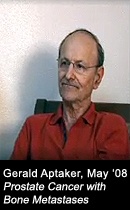 PSA decreased from 3,524 to 17.27 within 6 weeks and to 2.00 within 11 weeks
PSA decreased from 3,524 to 17.27 within 6 weeks and to 2.00 within 11 weeks
Watch Gerald Aptaker's testimonial. Mr. Gerald Aptaker was diagnosed as suffering from prostate cancer in 1996. A Doppler pelvic ultrasound and biopsy confirmed the diagnosis. The PSA level was 16 ng/ml with a combined Gleason score of 7. His doctors recommended surgery, however, the patient decided to seek alternative medical treatment in New York. From 1996 to July 2007 his PSA level kept rising. In August 2007 he started feeling weak, dizziness, and his urinary symptoms and the pain in his lower extremities returned.
In February 2008 the pain in his lower extremities intensified making it difficult to walk, and he started having pain in his cervical region. Laboratory results from April 29th 2008 revealed a PSA level of 3101 ng/ml. An abdominal and pelvic CT scan on May 8th 2008 showed a markedly enlarged prostate gland with possible tumor component posteriorly on the left, displacing the rectum, bone lesions suspicious of metastatic disease. The next day a total body bone scan revealed multiple areas of abnormal intense tracer uptake in bilateral ribs, thoracic spine, sacrum, pelvis and left femur consistent with diffuse osteoblastic skeletal metastases.
• After these results Gerald decided to come to the Issels Treatment Center for the comprehensive non-toxic immunotherapy. Gerald started the Issels Treatment on May 15th, 2008. At this time he complained of bone pain in his left iliac region that irradiated to his abdomen, and pain in the region of his right iliac bone that extended to his right lower extremity and that exacerbated during night and during walking. He had pain in both shoulders that limited his full arc of movements in his upper extremities, and neck, he also had costal right pain. He had no appetite and felt extremely weak. His PSA level on May 16th 2008 was 3524.
• Gerald underwent the comprehensive Issels immunotherapy without any complication and the laboratory study on June 4th showed that the PSA level dropped to 639.9. During his stay he manifested improvement in his overall wellbeing. His pain had almost subsided , his appetite improved greatly and his energy level went up. He was discharged on June 12th 2008 with a comprehensive follow up home treatment protocol.
• On July 1st 2008, 6 weeks after the start of the non-toxic Issels Treatment, laboratory studies at home showed a PSA level of 17.27 and the patient reports a substantial improvement in his quality of life, with practically no bone pain, no limitations in his range of motion and being in great spirits, eager to continue his complete home treatment protocol.
• Gerald's test on August 7th, 2008 showed that his PSA further dropped to 2.00.
• On January 21, 2009 the PSA was 1.07 and Gerald is very happy.
• On April 4, 2009 Gerald reports that his PSA dropped to 0.56 and he feels excellent.
Godine Weiss – Non-Small Cell Lung Cancer, inoperable, Stage IV (12/06/05)
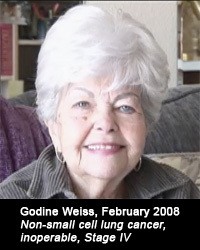 After 2 years of Issels Treatment, PET and CT scans show lung tumor now only scar tissue
After 2 years of Issels Treatment, PET and CT scans show lung tumor now only scar tissue
Watch Godine Weiss' testimonial. In October 2005, Godine Weiss was diagnosed as suffering from non-small cell Adenocarcinoma of the right lung in the apical zone measuring 3.1 x 1.7 cm, a left axillary lymph node measuring 1.8 x 1.2 cm, and a right hilar lymph node measuring 1.0 cm. The CEA tumor marker ranged up to 40, and she was anemic. Surgery was not possible and the patient did not opt for chemotherapy or radiation.
• Godine started the intensive 4-week non-toxic Issels Treatment including the vaccines on December 6th, 2005 and continued the follow-up home program for 6 months. The CT scan of June 28th, 2006 revealed a slight decrease of the left axillary lymph node from 1.8 x 1.2 cm to 1.5 x 1.1 cm.
• The PET / CT scan of June 4th, 2007 showed a further decrease of the left axillary lymph node to 1.4 x 0.9 cm and revealed that the tumor in the right lung has no metabolic activity any more and is consistent with scar tissue. The hemoglobin with 13.8 gr is in the normal range, as well as the CEA tumor marker with 2.6. Godine has no pelvic or abdominal metastases.
• According to the report of the scan of December 3rd, 2007 "there has been no interval change since the previous examination of June 4th, 2007." Godine comes for the regular complimentary follow-up visits to the Issels Treatment Center and continues to take the natural medications and supplements.
• In March 2008, Godine is in good condition and happy to report that she "graduated" and does not have to present for the 3-month checkups to her oncologist anymore. He said to her at her last visit: "You are a success, but not even my success". Her friends call her a miracle baby.
• March 2009 update: Godine is in good condition and great spirits. August 2010: "I am very thankful for my active life with family and friends." December 2010, five years later, Godine continues her active life.
Carolyn Murphy – Non-Small Cell Lung Cancer, Adenocarcinoma, with metastases (08/30/07)
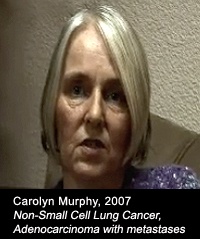 After 4 months of Issels Treatment significant decrease of the primary lung tumor and paratracheal lymphadenopathy
After 4 months of Issels Treatment significant decrease of the primary lung tumor and paratracheal lymphadenopathy
Watch Carolyn Murphy's testimonial. In June 2007, Carolyn Murphy, 50 years old, was diagnosed as suffering from Non-Small Cell Lung Cancer, Adenocarcinoma. The first CT scan of the Thorax revealed a mass in the upper right lobe, nodes of the subclavicular and tracheal area and multiple mediastinal adenopathies. Patient did not opt for chemotherapy or radiation.
• On August 30th, 2007, Carolyn came from England to undergo the 4-week comprehensive non-toxic immunological Issels Treatment program. The CT scan of the thorax on September 24th, 2007 showed anterior mediastinal adenopathy of 1.90 x 1.41 cm, para-tracheal adenopathy of 1.74 x 2.64, and peri-bronchial adenopathy right of 2.24 x 1.60 cm. The comparison of the CT scan with contrast performed in England on December 21st, 2007 with the one from July 26th, 2007 showed a significant reduction in size of the primary lung tumor and paratracheal lymphadenopathy.
• Carolyn gained weight and considerably improved her overall wellbeing. The CT scan with contrast performed on June 11th, 2008 by the same institution as in December 2007, showed further improvement. The right hilar node has decreased from 1.8 x 2,3 cm to 1.6 x 1.7 cm and the primary lung tumor in the right upper lobe has been diminished to a "small residual scar".
• In July 2008 Carolyn is very active and happy.
• In January 2009, Carolyn came for a follow-up visit to the Issels Treatment Center and everybody was happy to see her again in very good condition and high spirits.
Catherine Greene – Breast Cancer with Lung and Bone Metastases (01/27/04)
Remission of tumors
This very pleasant 71-year-old retired educator was admitted for comprehensive immunotherapy after an 11-year history of breast carcinoma and a history of uterine cancer. On discovery in 1993 of a 6-cm mass in her left breast, she accepted treatment with a modified radical mastectomy with lymph-node dissection (6 of 21 were positive for malignancy). Because of the lymphatic involvement and the size of the primary lesion, she was staged as IIIA (T3 N1 M0). Surgery was followed by chemotherapy with Cytoxan, methotrexate, and 5FU for many months. A 7-year symptom-free period was ended in February of 2003 with the development of left-sided lymphedema, weight loss, and a persistent dry cough.
A September 2003 PET scan of the lungs revealed multiple hypermetabolic foci within the neck, chest and skeleton. On the left side, the scalene and supraclavicular lymph nodes were involved, and on the right side the hilar nodal groups were active. Multiple skeletal lesions were observed in the right femur and ileum, the left acetabulum, a left rib/chest wall, and the spine at L4. The spinal lesion was again imaged by a CT scan of October 2003, and a whole-body bone scan at the same time clearly demonstrated a lesion at L3-4, as well as lesions of the left clavicle, and a left lateral rib. A routine PA and lateral chest x-ray revealed a 1.5-cm left mid lung mass which had been first identified in September 2003. On guided biopsy, she suffered a minor pneumothorax, but recovered without further incident.
• Her condition on admission January 27, 2004, was good, although the recent rapid spread of her disease was a pressing concern. She was initiated successfully with 28 days of hospitalization for oral and IV nutritional therapy, detoxification, multiple injections of Coley's toxins, and 4 PUVA-photopheresis sessions with manufacture of a take-home supply of frozen, live dendritic cells for period injections. Her ongoing treatment included consolidation with the Issels autologous vaccine.
• By January 2004, just before her admission to the Issels Treatment Center, C.G.'s most recent CT scans now revealed two lung tumors on the left, a 1.4-cm lingular nodule, and a new 1-cm lower left lobe nodule. A bone scan, also of January 2004, suggested progressive and newly extensive bony involvement with metastatic disease in the anterior calvarium, the left sternoclavicular region, several bilateral ribs, the sternum, the spine throughout its cervical, thoracic, and lumbar vertebrae, as well as multiple lesions in the pelvis, and at least two lesions in the right proximal femur.
•She was discharged in excellent condition. By the end of March 2004, after only two months of treatment, a CT of the chest revealed that the two previously described pulmonary nodules had decreased in size so much that the left lower lobe nodule was barely visible. A March 2004 pelvic CT noted both the lumbar spine metastasis and the irregular demineralization and sclerosis within the bony pelvis.
• A late-May bone scan showed a decrease in intensity of some of the central lesions raising the possibility of interval improvement, and by mid-July 2004 a pelvic CT no longer demonstrated demineralization or sclerosis, although a chest CT could still delineate the lingular mass in the left lung, and a new set of scans in November 2004 showed no real change.
• Over the December 2004 – January 2005 holidays, she was given a break from vaccinations, and vacationed with her family for five weeks. On her return to commence treatment once again, she had another round of CT scans (March 2005) and was rewarded with the finding her lungs are entirely tumor-free with only slight scarring. Her condition is robust; she has no cough, fever, sweats, or fatigue, and has resumed treatment with the intent to finish the job. October 2005, her spirits are high, and her energy excellent.
• May 25, 2007 follow-up: A PET scan compared to the one dated 11.28.2006 reveals the following: 1. Stable uptake in the left clavicle. 2. Stable hilar uptake, probably benign. 3. Widespread mottled appearance of the bones, but No FDG avidity, suggesting healed metastatic bone disease.
• Catherine is in excellent condition and wrote a letter to the Issels Treatment Center on December 2007: "I am so grateful for the Issels Treatment."
J.G. – Metastatic B Cell Lymphoma (12/30/05)
17 months after starting the Issels Treatment her tumor markers are normal, she has no more pain, feels excellent and leads a very active life
The 54 year old patient was diagnosed as suffering from B Cell Lymphoma Non-Hodgkin Folicular Low Grade in 2001. She chose no conventional treatment, but a strict diet. In 2005 she went through a period of high stress and began to experience symptoms such as intense pain in the left leg. In December 2005 CT and PET scans show metastatic disease in the left side of the sacrum. Her tumor sizes around the sacrum area measured 5.54 cm x 3.38 cm x 4.8 cm, with a volume of 44.94 cubic cm. She was also diagnosed with multiple nodules on the neck and suspicious lesions in L4 and T10 in the pelvic area.
• Again, she didn't undergo chemotherapy or other standard cancer treatment, but chose the Issels Treatment instead. To quote, in her own words, "My famous oncologist urged me not to fly from Australia to the Issels Treatment Center as I would die on the way." When she arrived at the Issels Treatment Center she complained of intense pain on the left leg and had difficulty walking. After the first weeks of treatment, the pain subsided.
In July 2006, after 7 months of treatment, the CT Scan shows reduction of the tumor lesions in the left side of the sacrum to 5.7 cm x 3.75 cm x 4.5 cm, and the volume of the tumor decreased to from 44.43 cubic cm to 42.77 cubic cm.
• On March 2007 her tumor marker CEA of 0.2 to 0.5 ng/ml were within normal range. She is pain-free, in excellent condition, and reports to feel better than she has felt in many years.
• June 23, 2007 update: Jenny reports that her oncologist in Sydney examined her thoroughly: "I am very happy for you that you are doing so well under the Issels Treatment."
D.R. – Breast Adenocarcinoma with bone and liver metastases (07/19/06)
After 1 month of Issels Treatment the liver and bone lesions show reduced metastatic activity
D.R., 74, started the Issels Treatment with a three-month-old diagnosis of breast cancer with metastatic disease on the liver, bones and peritoneum. She came to the clinic in a wheelchair, with extensive edema in the lower extremities, and her tumor marker Ca 27-29 was very high at 564.
After a month of treatment she was able to walk on her own, her edema in the lower extremities disappeared and her tumor marker decreased to 313. A comparison in CT Scans before and after 1 month of Issels Treatment showed a marked decrease of cancer activity in the liver and bones.
• After eight months into the Issels Treatment she is in very good condition and her tumor marker Ca 27-29 is down to 22.0.
• April 4, 2007 follow-up: reports to be in a very good condition. Her tumor marker is down to 17.
• April 21, 2007 update: The husband said in an email to one of the other Issels patients who has been in remission for 4 years now: "We are still in amazement."
W.C. – Prostate Cancer with bone metastases (07/06/05)
PSA decreased from 1,565 to 94 in 4 weeks
In his own words to Mrs. Issels on his day of discharge from the Issels Treatment Center: "The treatment result, the care by your doctors and nurses, the hospital atmosphere, simply everything surpassed my expectations."
The 68 year old patient was diagnosed as suffering from prostate cancer in 1995. He underwent surgery in 1996 and received hormonal treatment with Lupron. In 2003 bone metastases were diagnosed and treated with radiation. He became hormone refractory.
• In July 2005 he was admitted to the Issels Treatment Center with extensive very painful skeletal metastases which prevented him from walking. Upon admission his PSA count was 1,565 and during the 4-week intensive non-toxic Issels Treatment including the vaccines it dropped to 94 end of July 2005.
• He presented in November 2005 for his first follow-up visit in much improved condition and was able to walk again.
T. A. – Recurring poorly differentiated Synovial Sarcoma with Lung Metastases (04/13/05)
Remission of tumor masses
This 25 year-old woman developed a very fast growing tumor in her abdomen during the pregnancy with her first child. The tumor of a diameter of 11 x 8 cm was removed after the birth of her child in June 2004 and diagnosed as a poorly differentiated Synovial Sarcoma. In November 2004 several nodules were found in her lungs and the CT scan of February 2005 showed that they were increasing in size. In March 2005 a tumor with a diameter of 6 x 7 cm was diagnosed at the same site as the first tumor.
• In April 2005, the patient was admitted to the Issels Treatment Center with inoperable abdominal tumor masses that pressed against the pancreas, spleen, vena cava, diaphragma.and mediastinum. At that point the estimated life expectancy by her oncologist was one week! The intensive 4-week non-toxic Issels Treatment including the vaccine protocol was very carefully initiated and T. responded extremely well.
• She could breathe again without oxygen and her general condition continued to improve during her follow-up treatment at home. After 3 months the large tumor masses encapsulated into one operable tumor and the patient was referred to surgery.
• She recovered very well and continues the Issels Treatment. Her husband's own words in an email to the Issels Treatment Center on 09/09/2005: "T. is now a month out of surgery, and she continues to get stronger. Her incision is healing nicely, but still a little tender. There is not much pain anymore, and so she just a few days ago stopped taking her pain medication."
• He continues to write on 09/18/05: "T. feels great, and the Lord is blessing her with more energy everyday. She has been having so much fun playing with E., and cherishes every moment more after knowing what it was like to not be able to even get out of bed. The last CT Scan done (prior to this one) was before T.'s surgery, and this one from last week shows definite improvement from that. Most of the cancer in T.'s abdomen and chest is gone."
• December 2005: T. is continuing the Issels Treatment at home and leads a normal life.
L. S. – Mucoepidermoid Cancer of Parotid Gland (06/30/05)
Referring oncologist stunned with Issels Treatment Results
The 53 old patient was diagnosed as suffering from a Mucoepidermoid Cancer of the parotid gland in May 1999. He underwent resection of the parotid gland followed by chemotherapy. In April 2004, he had a recurrence with lung metastases and received his second chemotherapy to no avail.
• In June 2005, the patient was admitted to the Issels Treatment Center with heavy pain due to the tumor mass in his right lung and shortness of breath, which kept him from walking. He experienced marked improvement during the intensive 4-week in-patient non-toxic Issels treatment including the vaccine program, which he continued at home.
• His progress in his wife's own words on December 16, 2005: "Before we started the Issels Treatment in June 2005 my husband's oncologist, Dr. J., gave him only one more month to live. In October 2005, 4 months into the Issels Treatment, when he listened to L.'s lungs, he was stunned. The right lung, which was "dead" for over a year due to the tumor mass, is now starting to be perfused with air, and we could see it also on the X-ray. The check-up in December showed even further improvement and the oncologist could not conceal his astonishment. He even said he had never experienced that a patient in L.'s condition improved and survived that long."
J. R. – Recurring Infiltrative Ductal Breast Cancer with Bone Metastases (09/01/05)
40 percent shrinkage of recurring hard breast tumor within 3 months
The 65 year-old patient was diagnosed as suffering from Infiltrative Ductal Breast Cancer in April 2001. She underwent a lumpectomy followed by chemotherapy and hormone therapy. In 2002 the cancer recurred in her breast and spread to the bones. She contracted a pathological fracture in the lumbar region and received Zometa and radiation therapy. She also tried various alternative treatments to no avail.
• In September 2005, she was admitted to the Issels Treatment Center with a hard tumor mass that infiltrated 2/3 of her breast, an open wound in the scar where the operation was performed in 2001, extensive metastases to her hip, pelvis and lumbar area. Heavy pain prevented her from walking.
• She underwent the intensive 4-week in-patient non-toxic treatment including the vaccine program combined with a one week low dose radiation therapy to her lumbar region.
• She continued the Issels Treatment with the vaccines at home and presented to ITC for the first follow-up examination in December 2005. Her pain was gone and the hard tumor mass in her breast had shrunk by 40%. Patient J.R. was extremely happy and thankful for a regained life.
T.B. – Neurofibromatosis Type II (01/14/04)
Remission of tumors
Tamra's Progress with the Issels Treatments (in her own words).
• January 14, 2004 – started program
• January 17 – I was able to pinch my nametag clip. I haven't been able to pinch with my right hand in 6 months.(after 1st vaccine)
• January 19 – I was able to pinch my hair clippy.
• January 20 – The pinky on my left hand hadn't been able to fully point, it would just curve. Today my pinky moved straight and pointed. My left hand also has been able to stretch out with all the fingers together for months and today it was able to.
• January 20 – The tumor on my right wrist was very large and I have noticed it shrinking slightly.
• January 22 – I'm able to carry my meal tray around the cafeteria with both hands. I haven't been able to carry anything with both hands while walking in months and was unable to do so the first few days at Issels. My walking and balance is straighter and steadier each day.
• January 24 – The soft tumor on my right wrist and knotty on left elbow are shrinking. I turned the key in the very hard lock.
• January 26 – I was able to type with both hands. I haven't been able to do that in 6 months.
• January 30 – I was able to open/close a safety pin and open/close a ziplock bag. Both little but huge things since I haven't been able to in 4 months.
• February 1 – My balance and footing is better and straighter with steps and walking. I was able to turn the key in my car ignition and it's been very difficult to do for 6 months.
• February 5 – The tumor on my right wrist has shrunk a couple inches. (at this time I've had 6 dendritic vaccines)
• February 7 – I can pinch the therapeutic clay with my left hand and haven't been able to do that in 6 months.
• February 11 – I can pull Velcro apart using the fingers of both hands, which I haven't been able to do in 6 months.
• February 14 – I am able to step up 1 step straighter and steadier.
• February 17 – I performed an exercise where I was balancing while sitting on my knees and i haven't been able to do that in 4 years. I'm doing exercises I haven't been able to do in years because of so many surgeries that nerve damage has been involved and interferences with existing tumors. (At this time I've had 8 dendritic vaccines.)
• February 19 – First Issels vaccine
• February 25 – The soft tumor on my right wrist has shrunk another half inch, so in all it's shrunk 2 and a half inches in length and is also smaller in width. The coloring in my face is brighter and the whites in my eyes whiter.
• March 2 – My balance is steadier and I'm walking straighter. I can stand still for a couple minutes without knees shaking as much and I haven't been able to do that in 5 years without leaning on something. My feet are also closer together when walking. (At this time I've had my 10th dendritic vaccine and 3rd Issels vaccine.)
• March 7 – I can bend my knees and squat down and touch the floor then stand back up which I haven't been able to do in 4 years. While at the store I can squat and look at things on the bottom shelf. I'm just noticing steadier steps. I'm able to get up from the floor without the help of something or someone and my body is just overall working very well.
• March 10 – I bounced a ball with my left hand while walking. I haven't been able to do that in years.
• June 21 – "I wanted to let you know that I conquered the mountain on my 23rd birthday and stood at the top VICTORIOUS. It was an amazing accomplishment!!! God is so good! I did better then I expected and just walked straight up with little assistance. It's an awesome feeling to know I did that. A few years ago I went to a game at OU and had to have alot of help getting up the stairs and I was very unsteady but I headed straight up and only stopped once for a breath. I conquered those 83 steps and didn't even get sore after!!!!!!!!! God bless! Love, Tamra"
• July 10, 2004 – "I got back from Minnesota last week. I really had a great time and such great energy and walked good. I've been able to walk by myself a lot too-feeling steadier. The whole time I was there I was noticing accomplishments. I went out everyday for 2 weeks but did rest the day after my Issels vaccine. My friends in Minnesota kept going on and on about how good I was doing and what a change from when they saw me last January before I started treatments. I had a big accomplishment last week on the lake. I haven't ridden the boat in about 5 years b/c of the jarring and impact on your body. (I've had 6 surgeries in the last 7 years so my body was going through enough trauma). I rode it for an hour and did great! Also, my brother got me on the jetski with him and I haven't been on a jetski since I was 15. My body took everything well and I wasn't sore after! It was so awesome!!!!!!! It's Dad's fault because he had the idea of the OU stadium and I went for that so now I'm UNSTOPABLE!!-lol It's such an awesome feeling to be able to do this stuff FINALLY!!!!! God bless, Tamra"
• December 19, 2005 – "I'm doing good but have been crazy busy... My Christmas miracle this year is definitely my voice... I'm doing better with my energy and am working on my legs and balance. Well, talk more later but there's a little update for you! I hope you have a very Merry Christmas! Love, Tamra"
I'm continuing to progress with the treatments and constantly in awe at my accomplishments. I'm doing stuff now that I haven't been able to do in a long time. This summer I rode a jet ski and a boat, which I haven't done in 10 years. Since I started treatments that have resulted in improvements, I've talked about heading up the mountain instead of down. So on my 23rd birthday I headed up the OU stadium and stood at the top VICTORIOUS!!! God is good! It was an amazing feeling to know I did and could do that because a few years ago at a game I had to have a lot of help. Last year at this time I could do almost nothing with my hands but now I'm learning sign and doing the small everyday things that are so often done unconsciously. The tumor on my wrist and others are continuing to shrink. My doctors are excited and encouraged with my progress. They are amazed at how well my body is fighting and that the tumors aren't growing.
For 12 years the tumors have been active and damaging my body but through the treatments my body is constantly fighting to reclaim itself. Incorporating weekly vaccines and IVs into my school schedule has been hard because I've had no time for myself. Right when school is over for the week it's time for vaccine shots and the recovery that comes with them. However my body is adjusting better to this routine and the changes it's undergoing. At times it's still been hard but worth it because of the amazing changes I'm seeing. I've been on the treatments for almost a year and now have more energy, tons of improvements, and 500 shots to show for myself.
Tamra is a 22-year-old woman with an 11-year history of cranial, spinal, and other surgeries for neurofibromatosis type II, cerebellar pontine angle acoustic neuroma (Schwannoma). This disease strikes 1 in 50,000, and is widely regarded as an autosomal dominant disease of genetic origin, incurable, with no known treatments other than serial surgeries.
In mid-December, 2003, one month prior to her admission to the Issels Treatment Center, Tamra had been re-evaluated with MRIs of her cranium and cervical spine, as well as nerve conduction studies. In her cranial MRI, tumors too numerous to count were demonstrated in both ocular orbits, the mid falx, the left cerebellopontine angle cistern, the medical left temporal lobe, and the right and left medullary regions. In the MRI of her C-spine, multiple lesions were identified which had increased in both size and number in comparison with a scan of November 2002. Additional lesions were imaged at the top of the thoracic spine with signal characteristics suspicious for syrinx (fistula). Her physical evaluation and nerve conduction studies revealed continuing deterioration of leg strength and control, with the problem extending during the last year to her arms and hands. She exhibited significant weakness and atrophy of both hands, left greater than right. A large 6-inch-long neurofibroma was observed on the right volar wrist, and another on the left upper arm close to the elbow. she had a claw-hand appearance.
Nerve conduction studies both right and left ulnar nerves compromised below the elbows. In short, Tamra had difficulty walking or standing, needing considerable assistance, and her hands hung useless at her sides unable to either grip or extend. She could not dress or care for herself without assistance. Her right orbit lesion had resulted in proptosis, with the eye protruding and pointed downward. She was admitted to the Issels Treatment Center January 14, 2004. Within the first two months on the non-toxic treatment program, she experienced extraordinary recovery of nerve function, motor skills, and reduction of tumors. She continues her therapy at home, and keeps a treatment diary describing milestones in her recovery.
R.F. – Large Cell Endocrine Cancer (03/07/04)
Constant shrinking of tumors
This 63-year-old aircraft repair specialist and amateur swing dancer presented with a left-sided neck mass, which was found to be a large-cell neuroendocrine carcinoma of the nasopharynx. On staging, a lobulated mass was demonstrated replacing his left-sided superior nasopharynx and sprawling across the midline into the right-sided nasopharynx. Lymph nodes consistent with metastatic disease were demonstrated in the left retropharyngeal region, a large lobulated and matted left spinal accessory chain, as well as right-sided spinal accessory nodes.
This type of cancer, having the growth and metastatic tendencies of a primary large-cell pulmonary neuroendocrine tumor, is rapidly fatal despite standardized radical neck dissection, chemotherapy (lung cancer drugs) and aggressive radiation therapy. R.F. studied the proposed treatments and refused. His doctors told him his prognosis was bleak and that he should hurry to get his affairs in order.
• On admission to the Issels Treatment Center, R.F. exhibited an egg-sized mass protruding about halfway and engulfing the left-sided cervical lymph nodes. During his uneventful non-toxic treatment over 28 days, this mass softened and shrank to the point that it was no longer visible.
• Sequential MRI's (September and December 2004) reveal the complete disappearance of extracapsular tumor, leaving clearly defined lymph nodes. The nasopharyngeal mass has receded from the midline, and the left Eustachian tube has opened, restoring normal hearing and sensation.
• R.F. maintains a hectic dance card, traveling to far cities to compete in swing, ballroom, and country line dancing events. When he is not dancing, he enjoys biking 14 miles per day. He works full time in his aviation repair business and scrupulously continues his medical, nutritional, and vaccine treatments. His achievements thus far are extraordinary, and his outlook is excellent.
J.B. – Hodgkin's Lymphoma (03/09/04)
Remission of tumors
This 35-year-old man presented with a left neck mass in January 2003, which was biopsied positive for nodular sclerosing Hodgkin's disease. A CT scan revealed additional disease in the left supraclavicular, superior mediastinal, and prevascular spaces, while a corroborating PET scan demonstrated similar adenopathy as well as a 2-cm focal uptake in the splenic hilum. JB was treated with 6 cycles of ABVD from May 2003 through October 2003. On February 9, 2004, a palpable node in the left supraclavicular region was biopsied and found positive for recurrent nodular sclerosing Hodgkin's disease. He was declared resistant to ABVD, and urgent arrangements were made for transfer to Moffit Hospital immediately for high-dose chemotherapy and PBSCT. JB declined further chemotherapy.
• He contacted the Issels Information Center and was admitted to the Issels Treatment Center one month later, on March 9, 2004. His attitude, understanding and compliance were excellent. Since admission, he has received full treatment with integrative immunotherapy.
• Despite his oncologists dire warnings and urgency for the most aggressive of standardized treatments, JB is the picture of health today.
• A late December 2004 MRI revealed only enlarged lymph nodes at the site of the excision biopsy of his recurrence. A full MRI investigation of his head, neck, and abdomen were otherwise clear. He continues treatment in excellent condition with no complaints.
R.S. – Breast Cancer with Lung Metastases (03/04/04)
Remission of tumors
This 55-year-old Sudanese woman was first diagnosed with breast cancer in 1999, for which she underwent a mastectomy. She refused all chemotherapy, hormonal therapy, and radiation therapy, choosing instead to attempt control of the disease through nutritional treatment alone (wheatgrass, fresh vegetable juices, auto-urine therapy) for about 2 years. By May 2003, metastases had developed in her lungs, with an upper left lobe nodular density of 1.2 cm, and an upper right nodule of 1.2 cm.
R.S. chose to be admitted in June 2003 to the Oasis of Hope Hospital for the Contreras treatment. Although her tumor marker CA 27.29 reduced from 76 (normal is less than 38) to 34.1 by October 2003, a late-September CT scan revealed many new lung nodules with the largest of these measuring 2.6 cm on the right, and 1.7 cm on the left. By January 2004, her CA 27.29 was climbing again to 51.7, and it had reached 60 by February 2004.
• Therefore, in March of 2004, R.S. was discharged from the Contreras treatment and admitted to the Issels Treatment Center for comprehensive non-toxic immunotherapy. A CT scan (March 2004) revealed that the disease in her lungs had grown, with the largest on the right now 3.18 cm.
• Aggressive treatment was begun with vaccines (Issels autologous vaccine, Coley mixed bacterial vaccine, PUVA photopheresis/dendritic cell vaccine), internal medicine and nutrition. R.S. and her devoted husband labored vigilantly and were thoroughly compliant with all guidelines.
• A first follow-up CT scan in June 2004 demonstrated control of the disease with absolutely no changes in the number or size of the lesions. Finally, by October 2004, a new CT scan demonstrated significant interval decrease in size with the largest right-sided tumor shrinking from 3.18 cm to 2.3 cm in largest dimension (about 25% reduction in volume), with similar shrinkage of other smaller tumors.
• R.S. and her husband called the Issels Treatment Center in tears, joyful about the new CT results. Recent tests confirmed the slow healing process, with the last CT (January 2005) demonstrating additional mild interval improvement. R.S. is vitally healthy and energetic, as she has been throughout her treatment, which continues uneventfully.
B.S. – Metastatic Melanoma (10/06/03)
100% healthy today
This pleasant 44-year-old man was first diagnosed with a melanoma of the right posterior thigh on June 9, 2003, with metastatic melanoma found in the sentinel lymph node of the right groin in follow-up surgery on July 14, 2003. Therefore, his initial extent of disease was T3a, N1a, Mx, or stage IIIB. One month later, on August 13, 2003, a CT of the abdomen and pelvis identified a 2.5 x 3-cm soft tissue attenuation at the right cardiophrenic angle adjacent to the pericardium. A second 3-cm focal area of soft tissue attenuation was demonstrated in the right inguinal region. A September 2, 2003, PET scan revealed a very extensive 5 x 4-cm hypermetabolic area along the medial aspect of the right mid-to-lower lung field as well as a hypermetabolic area overlying the right femoral area. Because of the chest tumor, B.S. was now stage IV with a very poor and short prognosis. B.S. rejected surgical plans for a radical inguinal lymphatic dissection and open-chest surgery to remove the mass in the right pulmonary region.
• His family has been very involved and was instrumental in his decision to be admitted to the Issels Treatment Center in early October 2003 for comprehensive non-toxic immunotherapy. He was discharged in good condition on hospital day 29 having received diet therapy, internal medicine, vaccine-based immunotherapy (Coley, Issels), and PUVA-photopheresis with dendritic cell vaccine.
• A December 12, 2003, PET scan of the neck, chest, abdomen, and pelvis, as well as both lower extremities, demonstrated remarkable interval improvement, revealing only a single 3.5-cm hypermetabolic area at the medial aspect of the right mid-to-lower lung field, reduced from 5 x 4 cm. The hypermetabolic area in the right inguinal region had entirely disappeared. B.S. thrived on the treatment, losing 40 pounds from his overweight frame and gaining energy.
• Unfortunately, he stopped adhering fully to the vaccine management in early April (he discontinued the Issels autologous vaccine), but this was only revealed to his family after a PET scan of June 8, 2004, demonstrated that the hypermetabolic mass previously 3.5 cm had grown to 6 x 4 cm. The PET scan was confirmed by CT on June 10, 2004, which showed a 5 x 4-cm soft tissue mass density at the root of the ascending aorta and right lateral ventricle.
• On August 25, 2004, a complete right pulmonectomy was performed, and a grapefruit-size mass was removed. B.S. tolerated the procedure well, recovered uneventfully, and was discharged home where he resumed the full comprehensive non-toxic immunotherapy with remarkable, detailed, and emphatic support by his family.
• A follow-up CT in late December 2004 was completely clear, much to the astonishment of his surgeons according to family's account. As of March 2005, his brother reported that B.S. is fully recovered, back at work full time, and 100% compliant with the Issels treatment, which he plans to see through to its conclusion this time.
• Brian S., 03/30/05 Brother of patient B.S. in an email to the Issels Medical Team: "I have talked to many people about the Issels program since my brother, B.S., left the Issels treatment in the fall of 2003 (1 1/2 years already). I remain convinced that my brother would not be with us today were it not for the alternative and aggressive treatment he received under the Issels program. As you know my brother was a stage 4 melanoma patient but he showed no sign of detectable cancer at his last CT scan (Dec 9th, 2004). B. is 100% healthy today and even if that changes tomorrow our family would still be grateful for having enjoyed the past year with him. Since he has had no other treatment this success can only be attributed to Issels."
K.W. – High-grade Leiomyosarcoma (07/09/03)
Dramatic tumor reduction
A British sports hero began the Issels Treatment for his far-advanced, high-grade leiomyosarcoma that had been steadfastly refractory to multiple combination and high-dose chemotherapy since his diagnosis in May 2002. This list of failed chemotherapies was long and included Adriamycin/ifosfamide, high-dose ifosfamide, gemcitabine/Taxotere, and DTIC. Three weeks before his admission to the Issels Treatment Center, he had received very bad news: despite a conventional cancer treatment drug and all the other drugs before it, his disease was active, growing and disseminating.
There was CT evidence of an increase in the size of his rib metastases with the largest one bulging into the upper right lung; there was growth in several of his lung metastases; there was extension of his liver metastases, the largest of which 5 x 5 cm. A persistent left-sided hydronephrosis was unchanged and the responsible ureter-compressing gigantic lower-pelvic mass (10 x 9 x 8.5 cm) remained the same. A mass posturomedial to the left acetabulum had also grown to 3.5 cm and a new 1.5 cm nodule had appeared in his left adrenal gland. His spleen had been removed and the splenic parenchyma was 30% replaced by intermediate growing leiomyosarcoma.
• On admission to the Issels Treatment Center in June 2003, this former world class athlete was very weak and extremely hampered in range of motion of his right shoulder, unable to lift his arm above his head. He could not work, exercise or even lift his suitcase. On examination, his thorax was asymmetric, with pronounced right-sided muscular atrophy and edema. A 15-cm mass was palpable at his enlarged right scapular region. There was a visible protrusion measuring 3 cm on his posterolateral thorax at the level of the seventh rib. His liver was enlarged to 2 cm below his rib cage.
• During his stay, KW experienced dramatic tumor reduction of the palpable tumors. By November, his scapular and thoracic superficial metastases were barely detectable. He had gained weight and strength, regularly attended the gym for workouts, walked 1.5 miles to his daughter and walked the 1.5 mile return trip. He could lift normal weights, such as suitcases without difficulty. He had been painting his deck with his formerly immobile right arm, which now freely extended above his head.
• In January 2004 he returned for a short follow-up program in very good condition.
M.F. – Breast Cancer (01/07/03)
Remission of tumors
In October 2002, patient M.F. was admitted with infiltrating ductal carcinoma of the breast with extensive lymph involvement and bone metastases to her shoulder and several vertebrae. Her surgical pathology report of September 18, 2002, revealed high-grade infiltrating ductal carcinoma. Her largest tumor was the size of a small fist (8.3 cm), with 12 axillary lymph nodes replaced by tumor growth with extranodal extension and matting, the largest extension the size of a nickle measuring 2.4 cm. Her PET scan of Oct. 7, 2002, revealed metastases in the right scapular and left iliac boney structures, with probable metastases in her lower dorsal and lumbar spine. Infiltrated lymph nodes were demonstrated in the bilateral hilar and perihilar regions, the axilla, and a long peritracheal chain was visualized.
• She was on heavy pain medication, very nauseated and depressed. Within 2 weeks of being on the comprehensive non-toxic Issels Treatment including Coley's vaccine, a palpable chest wall metastasis disappeared. From the 19th day of the treatment she did not require any pain medication and was no longer nauseated. She regained her appetite and left the hospital in much improved condition and good spirits with instructions to continue her follow-up program at home.
• On January 7, 2003, a new PET scan revealed the following: "There is marked improvement in the interval with resolution of most of the bilateral hilar metabolic lymph node activity... There is marked diminished activity in what was thought to represent a metastasis to the right scapular region. There is resolution of a previous left pelvic lesion and several lumbar lesions seen on the study of 10/7/02. No new metastatic disease is seen on the current study."
• M.F. was seen mid-February by Dr. Yolanda Mejia at the Issels Treatment Center and was found to be in excellent health with wonderful prospects for the future. She returned home to complete her therapy and resume her productive life.
• From 06/27/03 until now, April 2004, M.F. has been under follow-up treatment at the Issels Medical Center in Phoenix, Arizona, and her health has further improved.
• April 2004, in her own words: "I am very grateful to Dr. Christian Issels and Dr. Jonathan Psenka. They have given me a very special treatment and I have not felt so good in many years. I can do things now that I could not do several months ago. My husband is overjoyed, as are my children and I can now resume my very active life. Also the PET scan of March 30, 2004 shows that I am stable."
L. S. – Mucoepidermoid Cancer of Parotid Gland (06/30/05)
Referring oncologist stunned with Issels Treatment Results
The 53 old patient was diagnosed as suffering from a Mucoepidermoid Cancer of the parotid gland in May 1999. He underwent resection of the parotid gland followed by chemotherapy. In April 2004, he had a recurrence with lung metastases and received his second chemotherapy to no avail.
• In June 2005, the patient was admitted to the Issels Treatment Center with heavy pain due to the tumor mass in his right lung and shortness of breath, which kept him from walking. He experienced marked improvement during the intensive 4-week in-patient non-toxic Issels treatment including the vaccine program, which he continued at home.
His progress in his wife's own words on December 16, 2005: "Before we started the Issels Treatment in June 2005 my husband's oncologist, Dr. J., gave him only one more month to live. In October 2005, 4 months into the Issels Treatment, when he listened to L.'s lungs, he was stunned. The right lung, which was "dead" for over a year due to the tumor mass, is now starting to be perfused with air, and we could see it also on the X-ray. The check-up in December showed even further improvement and the oncologist could not conceal his astonishment. He even said he had never experienced that a patient in L.'s condition improved and survived that long."
F.L. – Breast Cancer (02/17/03)
"I feel excellent."
This 41-year-old woman's breast cancer was originally diagnosed and treated in 1996 with a lumpectomy and a completely negative right axillary node dissection. Positive margins forced a segmental excision in September 1996. By January 1997, F.L. was operated for a recurrence in the surgical bed. She had a simple right mastectomy with a TRAM reconstruction, followed by 8 cycles of conventional cancer treatment drugs.
An emergency room CT scan for shortness of breath in February 2003 demonstrated bilateral right-greater-than-left pleural effusions, a right-pleural lobular density consistent with metastatic implants, and nodular densities within both lungs consistent with metastatic neoplasia. A CT-guided fine-needle aspiration biopsy on February 4, 2003, confirmed metastatic, well-differentiated carcinoma consistent with her 1996 breast primary. Bone studies of both February 7 and 11, 2003, demonstrated metastatic involvement of the spine at T3-T4.
• One week later, F.L. was admitted to the Issels Treatment Center where she was treated from February 17 through her discharge on March 15, 2003. Her second hospitalization at ITC ran from June 3 through June 25, 2003.
• In August 2003, F.L. started her follow-up treatment at the Issels Medical Center in Phoenix, Arizona, where the doctors in addition to using very thorough diagnostic methods imaged her matrix through electrodermal screening. They determined various functional blockades and eliminated these with a very personalized treatment including patient-specific IV solutions, glandulars, homeopathic remedies and others. Something shifted.
• The comparison of her CT scans from February 3 and September 11, 2003, revealed: her spinal metastases seen in February 2003 could not be imaged in September 2003, her pleural effusions had resolved, and a considerable regression of almost all lesions had occurred.
• In March 2004, she is leading a normal healthy life. In her own words: "I feel great!". In February 2003 she came to the Issels Treatment Center on oxygen and in August 2005 she is doing aerobics.
• "Jan 17th, 2006 Happy New Year! Yes, I think 2006 will be a great year. I feel really good. I will be going to Maui in February and Oklahoma/Texas in April this year. It's a traveling year. December 2007 I feel excellent."
Z.S. – Breast Cancer (04/14/03)
In December 2005: "I feel healthy."
This 25-year-old woman was diagnosed in January 2000 with a right-breast invasive ductal carcinoma, grade 2, stage II, T2N0 M0. In February 2003, she was found to have liver and lung metastases at the University Hospital of Kebangsaan, Malaysia. The largest of her 3 liver metastases was 4 x 3.5 cm, and the smallest about 1.5 cm in diameter. A 6-cm uterine lesion, probably a fibroid, was identified.
• She was admitted to the Issels Treatment Center in April 2003 with mild ascites and light peripheral edema. During her first week of treatment, she had an inflammatory reaction in the oropharynx and tonsils, which resolved. A thoracic CT done at ITC demonstrated the largest pulmonary lesion of the right lower lobe at 3.9 x 2.5 cm.
• On her return home, a repeat CT of July 2003 revealed reduction of the large right-lower-lobe tumor to 2.2 cm. Only one faint, small, 1-cm hypodense lesion was noted in the right lobe of the liver.
• The putative uterine fibroid itself was smaller at 5 cm. A follow-up chest x-ray at the University Hospital of Kebangsaan, Malaysia, in January 2004 was completely negative for lung lesions. An ultrasound by the university found only one 2.3 x 2.5-cm lesion in her liver. In mid-March 2004, Z. S. was seen at the Issels Treatment Center for follow-up and further treatment.
• Importantly, Z.S. was now seen to be in vital good health with restoration of regulatory functions, a strong appetite, and freedom from any of the symptoms associated with advanced malignant disease. Her prospect for continued recovery and complete immunization against recurrence is excellent.
• In December 2005 she came for a follow-up treatment of one week to the Issels Treatment Center. Z. continues to work full time in her job.
E.J. – Breast Cancer (11/9/03)
Disappearance of tumors
This 50-year-old woman from Budapest, Hungary, was diagnosed in January 2003 with a primary breast cancer. One of 10 lymph nodes was positive on modified radical mastectomy. She received both chemotherapy and radiation, but a CT of September 2003 demonstrated multiple mediastinal metastases and, in addition, 9 metastases in the right lung and 8 in the left (17 lung tumors in all). A 1-cm node was imaged in the right axilla.
• On admission to the Issels Treatment Center on November 9, 2003, EJ was counseled, educated, and initiated to multidisciplinary non-toxic immunotherapy. Her course in the ITC was unremarkable. She called from Hungary in mid-February to report that a CT of February 9, 2004, revealed the shrinkage and/or disappearance of at least 12 of 17 pulmonary tumors, and a major percentage of the mediastinal nodes had also regressed.
• She continues the therapy in excellent condition and ebullient spirits, with considerable interest expressed by her Hungarian oncologists.
C.M. – Cervical Cancer (09/09/03)
More self-reliant and stable
The 45 year-old woman was admitted in September 2003 to the Issels Treatment Center for treatment of advanced squamous cell carcinoma of the cervix, which had been originally operated September 1996 with a total abdominal hysterectomy and Wertheim's radical adenectomy with negative nodes. In May 2003, she developed severe lower-leg edema, high blood pressure, nausea, anorexia, fever, cramps, and diarrhea.
She was hospitalized in June 2003 with the above symptoms as well as pruritis and bilateral hydronephrosis, a creatinine of 20.1, indicating acute renal failure, and a left-sided nephrostomy tube was placed. She was subsequently treated with radiation and combination chemotherapy (cis-platinum and 5-FU), but disease persisted with multiple retroperitoneal metastatic nodes, and vertebral metastasis of L3.
• At the time of her admission to the Issels Treatment Center, she was again suffering complications of renal failure. Her condition has slowly improved during the first 6 months of being on the non-toxic Issels Treatment to the extent that she has become self-reliant and stable in all parameters.
• Her sister, M.L., wrote on March 18, 2004: "Dear Mrs. Issels, Thank you for your letter and for thinking of us. Catherine is doing well. Catherine has been keeping herself very busy. She insists on taking care of her 9-year old daughter, preparing her meals, taking her to school and going on school field trips, etc. She also shops for her own fresh vegetables for juicing as she is very particular about the quality of her produce. We are also grateful for this wonderful therapy and only wish more people were aware of it. Unfortunately, too many people rely on their doctors for conventional treatments without knowing all the facts. When Catherine's oncologist saw her last CT scans, he was amazed. Before we went to Issels, he was very skeptical about this treatment and unwilling to help us with it. He asked why we would choose to go to Mexico, of all places. Go to Japan or Europe, he said, or call M.D. Anderson or some of the other research hospitals in the U.S. Now I think we have his attention. He has been more helpful and seems to be watching to see what happens with this treatment. Last July, he didn't think Catherine would last a year. And certainly after the radiation and chemotherapy treatments he had prescribed, she was at death's door. Today she is up and about and feeling pretty good. As I said, she has not been sick in bed or in pain. Yes, we are very grateful for Dr. Issels' work." M. L. (sister of the patient)
D.P. – Prostate Cancer (04/23/03)
Bone metastases continuing to regress
The 65-year-old patient from England was admitted to the Issels Treatment Center in April 2003 for treatment of broad spread bone metastases from a prostatic primary demonstrated in February 2003 to be adenocarcinoma (Gleason grade 5+4=9) with 70% of the needle core biopsy tissue invaded. A whole-body bone scan of February 2003 revealed metastases to the mid- and lower cervical spine, the mid-thoracic spine, the lower thoracic spine at T10-11, the left pelvic iliac bone, and the subtrochanteric portion of the left femur. Additional radionuclide findings demonstrated sites in the skull and medial right clavicle. His PSA was 183 (normal reference range 0.0 – 4.0).
• A whole-body bone scan of September 2003 could no longer detect the right clavicular, left iliac crest, and lower thoracic spinal metastases. His PSA at that time was 1.78 (0.0-4.5).
• He returned to the Issels Treatment Center in October 2003 for routine follow-up examinations. His PSA was 1.3, and he was found to be in excellent overall condition with remarkable regression of bone metastases. His treatment was adjusted, and he continues as of Spring 2004 with a bright outlook.
E.R. –Stomach Cancer (02/08/03)
Disease Free
This 64-year-old gentleman from Puerto Rico sought treatment at the Issels Treatment Center for an incompletely resected gastric carcinoma status post partial gastrectomy and gastrojejunal anastomosis in December of 2002. The biopsy had revealed poorly differentiated, diffuse adenocarcinoma extending into the muscularis propria with both distal and proximal margins of resection positive for high grade dysplasia/carcinoma in situ. In addition, 1 of 4 lymph nodes was positive for metastatic carcinoma. He was staged T1b N1 Mx. He received no chemotherapy or radiation.
• As soon as he was recovered from the surgery, he was admitted to the Issels Treatment Center. Comprehensive immunotherapy was initiated and his course was without complications.
• In August 2003, a CT scan revealed "no evidence to imply the presence of recurrence or metastatic disease."
• He was most recently seen in follow-up at the Issels Treatment Center on March 15, 2004. He was found to be disease-free and in very good condition resuming his travels on business and pleasure.
R.B. – Thyroid Cancer (04/13/03)
Healthy since 1968
"My name is Robert Brotherwood. I was a patient at the Issels Clinic in December of 1968. I had thyroid cancer then and didn't have any hope left in the United States for any treatment to help me. My family Doctor, Dr. Rabe, suggested we try going to Germany for treatment because his son had been treated there years earlier and was still living."
• "I have been healthy since 1968, almost 35 years. I have competed in weight lifting competitions, ran 10 k races, and have been married 30 years and have 2 children. I recently started running again and have my goal set on competing again this fall in 10 k races."
• "I was surprised to see anything on the internet about Dr. Issels treatment. You can add me to the list of cured patients if you like. Please contact me if you want more information. Sincerely, Robert Brotherwood"
R.W. – Urinary Tract Cancer (10/23/02)
New hope
"My husband was diagnosed in January 2002 with urinary tract cancer (transitional cell carcinoma) in his right kidney, which was removed in March after a lump popped out on his neck. He started in April with combination chemotherapy (MVAC) for three courses, which he took through the middle of June, but his tumors continued to grow in spite of this treatment. Then, they switched him to taxol and gemcitabine for another 6 weeks, but the tumors grew and multiplied while he was taking them. They scheduled him for taxotere in late September, but we decided to go to Mexico instead.
• "Tomorrow, we're going home after an extraordinary, encouraging, 3-week experience at the Issels Treatment Center in Mexico. The tumors in his neck were so big you could not see his neck line anymore, but they have shrunk by 80% or 90% in response to combined low-dose radiation and biological treatment.
• "The latest x-ray showed that the tumors in his lungs are breaking up, and that he has more air space, just from the biological treatment. The doctors here know how to use standard treatments safely, and they know how to use the alternative biological treatments. They combine what I would call the best of both worlds, to meet the needs of the patient. Dr. Mejia, our excellent and caring doctor, was always available when we needed her."
• "She had a solution for every critical situation with his very advanced cancer. My husband and I are very grateful to her, to Gar and Christeene Hildenbrand, and to the whole team. We are leaving this special place with new hope, and we will continue the follow-up treatment at home according to the meticulous instructions we received."
K.K. – Colon Cancer (10/10/02)
"Happy to have found the Issels Treatment Center"
"I am happy to have found the Issels Treatment Center in Mexico. When I arrived here about 2 weeks ago with my advanced colon cancer that had spread to the liver and other organs, the fluid in my abdomen built up so fast that it had to be tapped every 3 days. My kidneys were failing and my pulse was 120 due to the problems the cancer posed to my heart. I was not strong enough to go to the bathroom on my own. Now, I am walking again. I did not have to be tapped once since my arrival here. As a registered nurse I can understand the work Dr. Mejia is doing and appreciate especially the results she is getting with me."
St. W. – Esophageal Cancer (10/10/02)
Personalized treatment
"What a decisive difference: Not being given up to die, but to be treated by a doctor who uses all her skills and tools to fight with you, and who has the experience to have helped in similar conditions. When I arrived at the Issels Treatment Center a few weeks ago with my very advanced esophageal cancer, that had metastasized, she had to cope with many complications due to my progressing cancer and due to omissions of the previous treatment."
"Dr. Mejia treated me in a very personalized way and helped me tremendously. I am very grateful to her, and to the caring and competent staff of the Issels hospital. It is a modern hospital that meets US standards and I was impressed with the newest equipment I saw here. All the necessary specialty services are available. I would also like to mention that the hospital is very clean. My room was cleaned twice a day. The majority of patients are coming from the United States and in the hospital there is no language barrier. All the doctors speak fluent English, as many of the staff members do. Now I continue the program at home with confidence."
I.P. – Melanoma (10/07/02)
Tumors markedly shrinking
"I came here from England, because I had heard so much about the Issels Treatment. For 5 months at home, I was on a very intensive famous dietary regime, but my melanoma tumors continued to grow all over my skin."
"Now, 3 weeks into the Issels Treatment with the Coley's vaccine, all of my tumors are markedly shrinking. Sometimes I think it is a dream and I do not dare to wake up, but the treatment makes sense and I believe in it seeing that other patients respond, too."
R.H. – Melanoma (09/29/02)
No additional tumor growth
"Dear Mrs. Issels, I am e-mailing you because I want you to know how pleased I am with the treatment I just received at the Issels hospital. After being there for only a couple of days I was convinced that the Issels therapy was the best program for me. My confidence continued to grow every time I listened to Gar speak, and I was totally convinced that I would be cured after listening to your presentation, and looking at the many before and after slides of patients that had been cured and survived 20, 30 even 40 years and more. I must tell you I was apprehensive about going to Mexico as I was not sure of the quality of the treatment I would receive, or the quality of the hospital and its personnel".
"After meeting Dr. Mejia and some of the other doctors, as well as Minerva and several of the nurses that attended to me, my apprehension quickly dissolved. I have complete trust in Dr. Mejia, she is one of the finest doctors I have ever met. She instills confidence in me and great hope for the future. My entire three week stay at the hospital was a positive one. Being able to meet and talk with the other patients and share hopes and concerns was very important. I can't thank you enough for your continued support and the genuine concern you have shown for my well being. Warm Regards, R.H."
"October 09, 2002 As you know Mrs. Issels I have melanoma, and during the two months prior to implementing the Issels treatment the large tumor in my stomach cavity had doubled in size. However the cat scan taken right before I left the Issels hospital indicated that my tumor had stopped growing. That in itself is no small miracle, and I attribute it all to the treatment I received at the hospital. With my continued treatment at home I feel confident that we will not only stop the tumor but reduce it and eventually eliminate it."
"October 30, 2002 Dear Mrs. Issels, This is a current update. My cat scan of 10/21 continues to indicate no additional growth of the tumor in my stomach cavity. In addition, some very encouraging news: It looks like a portion of the tumor is beginning to lose its blood supply. As you know, if this continues it is just a matter of time before the tumor dies."
D.S.D. – Colon and Stomach Cancer (09/23/02)
Able to eat and drink again
"I am so happy to be back at the Issels Hospital and treated as a person again, not as a cancer patient given up by his doctors to die! In the hospital at home where I had to be on antibiotics for an infection, almost every day 2 or 3 doctors came to my room telling me that I would soon fall into a coma. And yet, the CT-scan showed that my previously progressive colon and stomach cancer had stopped growing since I had started the Issels Treatment two months earlier."
"They were adamant asking me to sign that I do not want to be resuscitated. Such an attitude of my treating doctors was extremely frightening to me and had no healing effect. I was anxious to be released and to return to Dr. Mejia, my very caring physician at the Issels Treatment Center Hospital in Mexico, who had helped me in a very critical condition during my first stay."
"When I started the Issels Treatment the only nutrition I could take was through the vein. My esophagus was so blocked that I could not even drink water. The whole stomach area was rock hard. Several hours after the first vaccine injection my stomach softened and 3 weeks after I returned home I could drink and even eat solid food again. The catheter for the intravenous nutrition was removed. I am forever grateful to Dr. Mejia for her dedication to her patients. (Metastatic adenocarcinoma of the colon)."
R.B. – Leiomyosarcoma (09/18/02)
Feel like a human being again, not just a cancer case
"Three months ago when my brother with lung cancer and bone metastases (non-small cell lung cancer) went to the Issels Treatment Center, I thought of accompanying him and having my stomach cancer with liver metastases treated by you, too. (Leiomyosarcoma of the small intestine). However, my oncologist discouraged me. He put me on an experimental drug that did not work for me. My brother came back and felt better every day while I was getting sicker and weaker every day. After only two months, his metastases to the spine (T3 and T4) that had started to erode the ribs, could not be found on the CT-scan any more."
"Ten days after I finally began my treatment at the Issels Treatment Center I could not believe what I experienced: Not only have I felt better and stronger already after a few days, but after the first injection of the vaccine the tumors have clearly softened. Now, after 3 weeks my distended stomach has flattened and I cannot feel the tumor in my liver any more. I trust my doctor, Dr. Mejia, and am very fond of her. I could not have found a better doctor. Everybody at the Issels Hospital is very warm and caring. One feels like a human being again and not just a cancer case."
I.C. – Small Cell Lung Cancer (08/22/04)
"Resumed my work again."
"I have small cell lung cancer with bone lesions. I improved so much due to the Issels Treatment that 4 weeks after returning home, I have resumed my work again. I wished I would have found your hospital earlier."
A.M., M.D. – Leukemia (09/04/02)
Impressed by the science
"I am impressed by the science behind the Issels Treatment, and I thoroughly enjoy the lectures by your epidemiologist, Gar Hildenbrand. Your attending physician, Dr. Mejia, is excellent. She is not only warm and caring, but a very competent internist and instills confidence in us patients. The education and guidance of the patients at the Issels Treatment Center is extraordinary, the whole atmosphere of the Issels Hospital is very special, a true healing environment." (A.M. is a medical doctor suffering from an aggressive leukemia.)
• December 4, 2002: The bone marrow aspiration of 12/04 showed "No trace of minimal residual disease." This is an exceptional response with the aggressive Acute Myeloblastic Leukemia that received only 1 full course and 2 low dose courses of chemotherapy. This outcome was achieved through the combination of chemotherapy with the immunobiological treatment. The patient will continue the combination treatment during the following months to consolidate the result.
• April 8th, 2004: "I have not had any chemotherapy for over a year and am in complete remission. My hematologists are astonished and I feel great."
• June 16th, 2004: "I have not had any chemotherapy for 18 months now. I am in full remission and in excellent condition."
E.N. – Pancreatic Cancer (08/21/02)
Extended life expectancy
"When my father R.N. came to the Issels Treatment Center in May 2002, he had a total obstruction of the bile-duct from his aggressively growing adenocarcinoma of the pancreas with liver metastases. The doctors in New York he consulted, among them from the Sloan Kettering Institute, gave him about 3 months to live with or without chemotherapy. He chose the non-toxic Issels Treatment."
"Upon admission, he had to have a double by-pass surgery of the bile-duct at your hospital. Two days later he was on his feet again. Now 4 months later, the CT-scan performed at the same institution as the initial one in April 2002, shows no progression of the cancer. I want to mention that it is very reassuring to know that your team of doctors is so experienced in the conventional and alternative medical field."
S.W. – Breast Cancer (08/17/02)
Enjoy daily activities again
"The two 3-week treatments at the hospital within 3 months for my breast cancer with lung metastases (infiltrating ductal breast cancer) have given me back my life. I enjoy my daily activities again, and I am now even able to do my gardening. Also my tumor markers that were very high when I arrived, almost normalized. My daughter M. and I like the homey atmosphere of the Issels Hospital in Mexico so much. We enjoy meal times when patients and their companions meet in the cafeteria. They come from all parts of the world, such as the United States, Europe, Australia, South Africa, Arabia, Singapore, Japan."
"Many patients already get better during the first weeks of their treatment which is very encouraging. It is a big family, and one member supports the other. The psychological guidance is very important and I love Dr. Mejia, she is like a best friend to me. Sometimes, my daughter and I felt like being on vacation. Every afternoon and evening there was something going on: Lectures, physical therapy, breathing exercises, prayer sessions, laughter-sessions, sing-alongs with Gar and Christeene Hildenbrand, which are very uplifting, educational videos."
"The missionaries are available 24 hours a day to comfort patients, when needed. My friends at home cannot understand that I look forward to my next stay at the Issels Treatment Center at the Hospital." (The CT-scan in September 2002 showed some lung tumors look smaller).
J.M. – Prostate Cancer (08/11/02)
Cancer free in 2005
"I refused all conventional treatments for my prostate cancer. When my PSA started to rise so fast I got really scared. It took only a 3-week Issels Treatment including the Coley's vaccine, and my PSA has been dropping. I continue the treatment with a lot of hope."